編譯原理(前端)的演演算法和實現
編譯原理(前端)的演演算法和實現
本文介紹從零實現Lex+YACC(即一鍵生成編譯器(前端))的演演算法。完整程式碼在(https://gitee.com/bitzhuwei/grammar-mentor)和(https://github.com/bitzhuwei/GrammarMentor)。
下文將用「解析器」指代編譯器前端(即詞法分析和語法分析)。
本文主要以四則運算為例,其文法如下:
// GrammarName = Calc
// ExtractedType = FinalValue
Additive : Additive '+' Multiplicative // R[0]
| Additive '-' Multiplicative // R[1]
| Multiplicative ; // R[2]
Multiplicative : Multiplicative '*' Primary // R[3]
| Multiplicative '/' Primary // R[4]
| Primary ; // R[5]
Primary : '(' Additive ')' // R[6]
| 'number' ; // R[7]
// 用 %%xxx%% 格式 描述單詞
'number' : %%[0-9]+%% ; // 為便於演示,僅處理正整數
本文按如下順序進行:
-
手工實現四則運算
Calc的解析器CompilerCalc。 -
總結出文法的文法
Grammar。 -
手工實現文法的解析器
CompilerGrammar。 -
用
CompilerGrammar一鍵生成CompilerCalc。 -
用
CompilerGrammar一鍵生成CompilerGrammar。
練手預熱——四則運算解析器CompilerCalc
從原始檔內容string到單詞流TokenList到語法樹Node到語意結構TExtracted,是各種解析器共同的處理過程。
如果從原始檔讀到的內容是46*(87-19),我預想中的CompilerCalc會逐步給出如下的資料:
// 原始檔內容string:
46*(87-19)
// 詞法分析的結果:單詞流TokenList:
T[0]='number' 46 [ln:1, col:1, i:0, L:2]
T[1]='*' * [ln:1, col:3, i:2, L:1]
T[2]='(' ( [ln:1, col:4, i:3, L:1]
T[3]='number' 87 [ln:1, col:5, i:4, L:2]
T[4]='-' - [ln:1, col:7, i:6, L:1]
T[5]='number' 19 [ln:1, col:8, i:7, L:2]
T[6]=')' ) [ln:1, col:10, i:9, L:1]
// 語法分析的結果:語法樹Node:
R[2]=Additive : Multiplicative ; T[0->6]
└─R[3]=Multiplicative : Multiplicative '*' Primary ; T[0->6]
├─R[5]=Multiplicative : Primary ; T[0]
│ └─R[7]=Primary : 'number' ; T[0]
│ └─T[0]='number' 46
├─T[1]='*' *
└─R[6]=Primary : '(' Additive ')' ; T[2->6]
├─T[2]='(' (
├─R[1]=Additive : Additive '-' Multiplicative ; T[3->5]
│ ├─R[2]=Additive : Multiplicative ; T[3]
│ │ └─R[5]=Multiplicative : Primary ; T[3]
│ │ └─R[7]=Primary : 'number' ; T[3]
│ │ └─T[3]='number' 87
│ ├─T[4]='-' -
│ └─R[5]=Multiplicative : Primary ; T[5]
│ └─R[7]=Primary : 'number' ; T[5]
│ └─T[5]='number' 19
└─T[6]=')' )
// 語意分析的結果:extracted:
3128 = 46 * ( 87 - 19 )
詞法分析器
我設定,用'xxx'的形式表示Token,也就是用'前後包圍起來。
詞法分析的原理是自動機/狀態機。自動機可以用正規表示式來表示。
上文中的[0-9]+是一個正規表示式,表示「1個或多個0到9」,也就是0或正整數。Lex的主要功能就是將字串格式的正規表示式轉化為自動機,再將自動機轉為等價的程式碼形式。
我設定,描述Token的正規表示式,用%%前後包圍起來。
如果文法中的某個Token沒有明示其正規表示式,那麼它的字面本身就是它的正規表示式。準確來說,它的字面本身就是它的正規表示式的內容(在涉及跳脫字元時會有區別)。例如'+'和'(',它們隱含的正規表示式分別是%%[+]%%和%%(%%。當然,%%[+]%%可以換為%%\+%%或%%\u002B%%。
我們可以手工畫出識別Calc文法的全部Token的自動機。
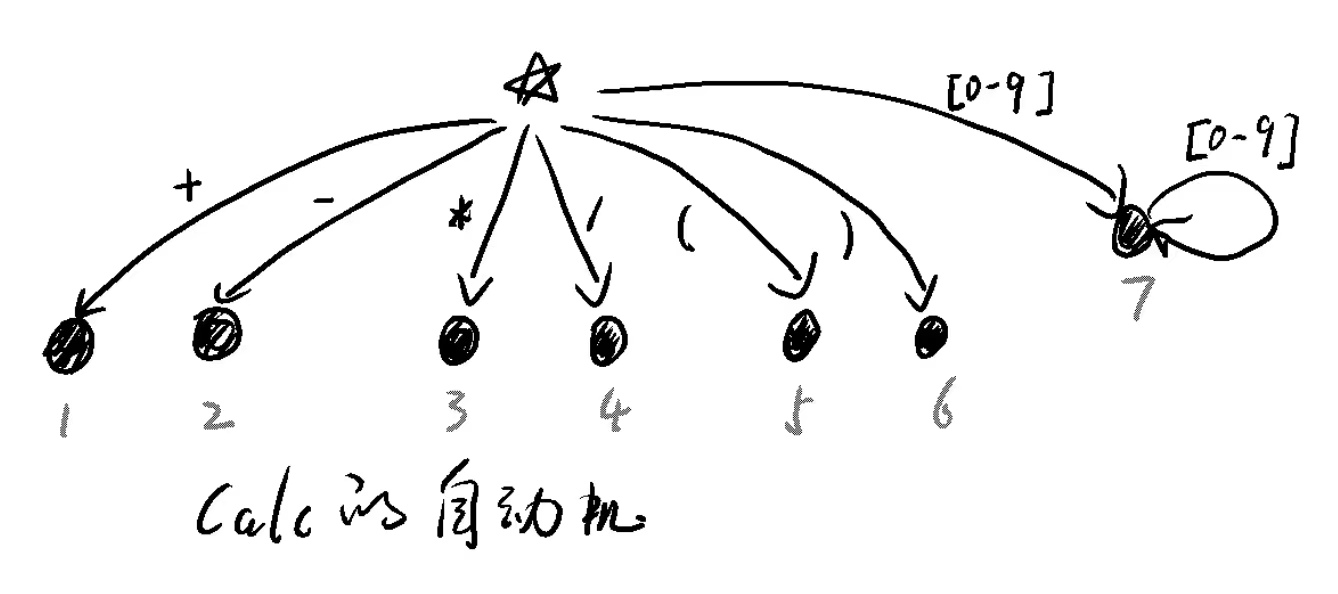
圖中的☆代表初始狀態initialState。
以圖中的狀態7為例:
-
對於一個沒有詞法錯誤的原始檔,當詞法分析器讀入的
char是[0-9]中的某個時,就可以斷定接下來會遇到的是一個'number'型別的Token,並進入它的終止狀態7; -
之後可以繼續收集此
Token的內容; -
當讀到一個不屬於
[0-9]的char時,會從終止狀態7返回initialState。也就是說,對於每個狀態A,都有一條沒有被畫出來的邊,從狀態A指向initialState;initialState本身也是如此。有的文章將這種狀態稱為「死狀態」。有死就有生,有生就有死。死就是生,生就是死。「死狀態」就是初始狀態☆。
現在我們手工將此自動機轉化為C#程式碼。
對於initialState,也就是lexicalState0:
private static readonly LexicalState lexicalState0 = new LexicalState(
new LexicalRule(/* ☆ --> 1 */
currentChar => currentChar == '+',
context => {
BeginToken(context, EType.@Plus);
ExtendToken(context);
return lexicalState1; // go to state 1
}),
new LexicalRule(/* ☆ --> 2 */
currentChar => currentChar == '-',
context => {
BeginToken(context, EType.@Dash);
ExtendToken(context);
return lexicalState2; // go to state 2
}),
new LexicalRule(/* ☆ --> 3 */
currentChar => currentChar == '*',
context => {
BeginToken(context, EType.@Asterisk);
ExtendToken(context);
return lexicalState3; // go to state 3
}),
new LexicalRule(/* ☆ --> 4 */
currentChar => currentChar == '/',
context => {
BeginToken(context, EType.@Slash);
ExtendToken(context);
return lexicalState4; // go to state 4
}),
new LexicalRule(/* ☆ --> 5 */
currentChar => currentChar == '(',
context => {
BeginToken(context, EType.@LeftParenthesis);
ExtendToken(context);
return lexicalState5; // go to state 5
}),
new LexicalRule(/* ☆ --> 6 */
currentChar => currentChar == ')',
context => {
BeginToken(context, EType.@RightParenthesis);
ExtendToken(context);
return lexicalState6; // go to state 6
}),
new LexicalRule(/* ☆ --> 7 */
currentChar => '0' <= currentChar && currentChar <= '9',
context => {
BeginToken(context, EType.@number);
ExtendToken(context);
return lexicalState7; // go to state 7
}),
new LexicalRule(/* ☆ --> ☆ */
currentChar => IsOther(currentChar),/*非以上字元*/
context => {
char c = context.CurrentChar;
if (c == ' ' || c == '\r' || c == '\n' || c == '\t' || c == '\0') { return lexicalState0; }
// default handler: unexpected char.
var token = new Token(context.Cursor, context.Line, context.Column);
token.value = c.ToString(); token.type = EType.Error;
context.result.Add(token);
return lexicalState0; // go to state 0
})
);
對於狀態7:
private static readonly LexicalState lexicalState7 = new LexicalState(
new LexicalRule(/* 7 --> 7 */
currentChar => '0' <= currentChar && currentChar <= '9',
context => {
ExtendToken(context);
return lexicalState7; // go to state 7
}),
new LexicalRule(/* 7 --> ☆ */
currentChar => IsOther(currentChar),/*非數位*/
context => {
AcceptToken(context, EType.@number);
return lexicalState0; // go to state 0
})
);
自動機與程式碼是一一對應的。其他狀態不再重述。
呼叫自動機的過程是所有解析器通用的,因此應當獨立出一個基礎類庫:
public TokenList Analyze(string sourceCode) {
var context = new LexicalContext(sourceCode, this.initialState);
while (!context.EOF) {
char currentChar = context.CurrentChar;
Func<LexicalContext, LexicalState> function = context.GetFunction(currentChar);
LexicalState nextState = function(context);
context.currentState = nextState;// prepare the current state to meet with next char.
context.MoveForward();// move cursor to next char
}
// finish lexical analyzing with external char('\0').
{
char currentChar = context.CurrentChar;
Func<LexicalContext, LexicalState> function = context.GetFunction(currentChar);
LexicalState nextState = function(context);
// practically not needed.
context.currentState = nextState;// prepare the current state to meet with next char.
context.MoveForward();// move cursor to next char
}
return context.result;
}
用'\0'收尾,是一個程式設計處理的小技巧。在語法分析時,也會用到類似的技巧。
語法分析器
文法裡都有什麼
我按下圖所示稱呼文法中的各個部分:
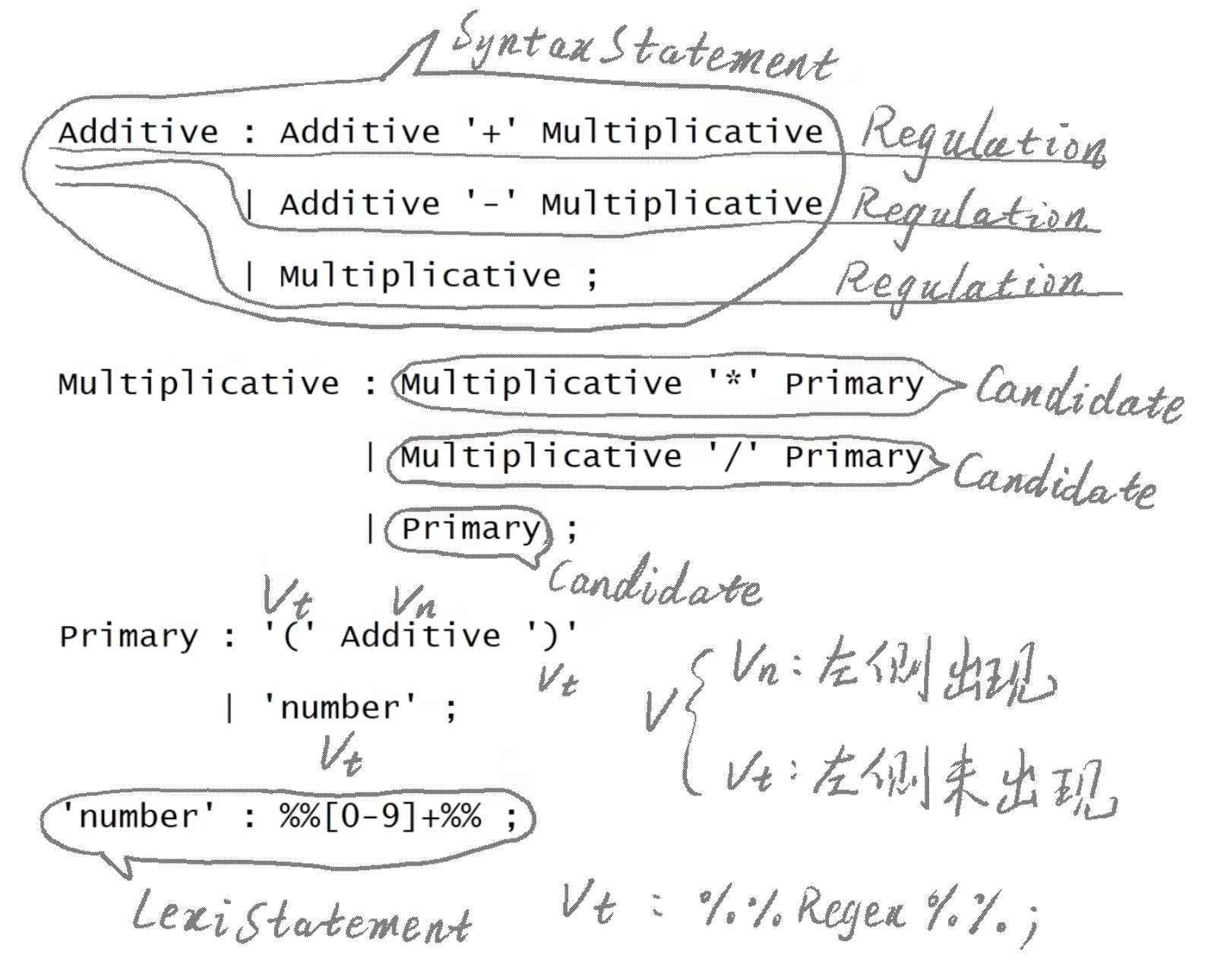
回看上文預想中的語法樹,可知,每個語法樹的葉結點,都對應一個Token。如果按後序優先遍歷的方式過一遍語法樹,就可以得到依索引排列的TokenList。這說明,語法樹是對TokenList的進一步組織,語法樹的葉結點型別與Token型別完全重合,非葉結點型別則是自己獨有的。
本文用Vt(terminal)表示葉結點,用Vn(non-terminal)表示非葉結點,用V表示兩者的總和。
語法分析三大件
nullable(VList)
如果一個V可能推匯出空ε,也就是說,一個Vt都沒推出來,那麼我們就說它是可空的,即nullable(V)=true。
如果一串V可能推匯出空ε,也就是說,一個Vt都沒推出來,那麼我們就說它是可空的,即nullable(V1 V2 V3 ..)=true。
顯然,對於任何Vt,nullable(Vt)=false。
FIRST(VList)
一個V,它能推出的第一個Vt都有誰呢?這些Vt合起來,就是FIRST(V)。
一串V,它能推出的第一個Vt都有誰呢?這些Vt合起來,就是FIRST(V1 V2 V3 ..)。
顯然,FIRST(V1 V2 V3 ..)包含FIRST(V1);如果nullable(V1)=true,那麼FIRST(V1 V2 V3 ..)也包含FIRST(V2);以此類推。
如果nullable(VList)=true,那麼FIRST(VList)包含空ε。
FOLLOW(Vn)
在所有的Regulation中,緊跟在Vn後面的Vt都有哪些?這就是FOLLOW(Vn)。
顯然,在left : 某V 某V .. Vn V1 V2 .. ;中,FOLLOW(Vn)包含FIRST(V1 V2 ..);如果FIRST(V1 V2 ..)包含空ε,那麼FOLLOW(Vn)包含FOLLOW(left)。
LL(1)分析法
以下面的文法SAB為例:
S : A 'a' 's' // R[0]
| B 'b' 's' // R[1]
| 'd' ; // R[2]
A : 'a' ; // R[3]
B : 'c' // R[4]
| empty ; // R[5] empty means (ε)
對於一個沒有語法錯誤的TokenList,如果語法分析器讀入的第一個Token是'a',就可以斷定應當使用R[0]展開/推導,因為在R[0]、R[1]、R[2]中,只有R[0]的FIRST(A 'a' 's')包含'a',也就是說,只有R[0]能匹配一個內容為'a' Vt1 Vt2 ..的TokenList;如果用R[1]或R[2],就不可能使第一個Vt為'a'了。
抽象化地說,只要語法分析器讀入一個Token,就可以根據它的型別斷定,應當使用哪個Regulation。憑什麼呢?就憑對於當前結點(上例中是S)的所有Regulaion,FIRST(R[0])、FIRST(R[1])、FIRST(R[2])全都沒有交集。
這就是LL(1)文法的核心思想。這與詞法分析器有相似之處。
對於上面這個文法,可以用LL(1)分析法。但Calc文法不能用LL(1)分析,因為
FIRST( Additive '+' Multiplicative ) = { '(' 'number' }
FIRST( Additive '-' Multiplicative ) = { '(' 'number' }
FIRST( Multiplicative '\*' Primary ) = { '(' 'number' }
各個Regulation的FIRST集都有共同的Vt(即'('和'number')。當詞法分析器讀到一個'number'時,它該用哪個Regulation展開/推導呢?它不知道呀。
LR(0)分析法
以Calc的原始檔46*(87-19)為例:
最初,我左手上是第一個Vn(Additive);右手上是一個沒有語法錯誤的TokenList,也就是未來的Vt串。
我只在最抽象的程度上知道:這個Additive對應著整個TokenList(即T[0->6])。
現在,我需要讓Additive具體地對應上TokenList,也就是逐步地展開/推導它,也就是具體化。
Additive有3個Regulation,每個都對應一個展開/推導的可能路線。問題是,選哪個?
從左手上看,我面對是的一個抽象的Vt串;從右手上看,我面對的是一個具體的Vt串。
從左手上看,我位於抽象的Vt串的開頭;從右手上看,我位於具體的Vt串的開頭。
觀察左手,由於R[0]、R[1]、R[2]的存在,實際上我是位於Additive '+' Multiplicative的開頭或Additive '-' Multiplicative的開頭或Multiplicative的開頭,也就是Additive的開頭或Multiplicative的開頭。這就向具體化邁進了一步。
繼續觀察Multiplicative,由於R[3]、R[4]、R[5]的存在,實際上我是位於Multiplicative '*' Primary的開頭或Multiplicative '/' Primary的開頭或Primary的開頭,也就是Multiplicative的開頭或Primary的開頭。這就又向具體化邁進了一步。
繼續觀察Primary,由於R[6]、R[7]的存在,實際上我是位於'(' Additive ')'的開頭或'number'的開頭,也就是說,我直接面對的是'('或'number'。這就又向具體化邁進了一步。由於'('和'number'是Vt,就沒有繼續展開的可能了。
像用放大鏡觀察物體一樣,我們一級一級地放大觀察當前直接面對的Vn,直至沒有Vn可放大。這個過程,就是求解閉包(Closure)的演演算法。之所以閉包中的各個項(Item)算作處於同一狀態,是因為它們本來就在描述同一狀態,只不過是在不同的放大級別上描述同一狀態。
此時已經能夠斷定,我們首先面對的,只會是'('或'number'。
如果語法分析器讀入的第一個Token是'(',那麼可以立即斷定,應當選擇R[6]展開/推導。此時,我將移進(shift-in)到Primary : '(' ⏳ Additive ')'中的⏳處,意思是,我讀到了'(',我期待著讀到Additive ')'。這提示我們,在讀入第一個Token之前,我們是位於如下圖所示的⏳處:
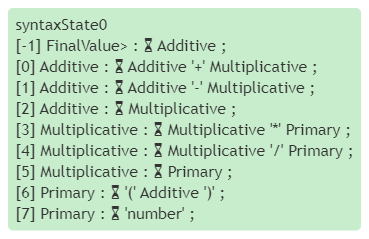
syntaxState0
[-1] FinalValue> : ⏳ Additive ;
[0] Additive : ⏳ Additive '+' Multiplicative ;
[1] Additive : ⏳ Additive '-' Multiplicative ;
[2] Additive : ⏳ Multiplicative ;
[3] Multiplicative : ⏳ Multiplicative '*' Primary ;
[4] Multiplicative : ⏳ Multiplicative '/' Primary ;
[5] Multiplicative : ⏳ Primary ;
[6] Primary : ⏳ '(' Additive ')' ;
[7] Primary : ⏳ 'number' ;
圖中的[-1]是為了便利程式設計新增的額外起始Regulation,也就是後文將介紹的擴充套件Regulation。
仿照上面的步驟,可以找到 Primary : '(' ⏳ Additive ')'的閉包,也就是:
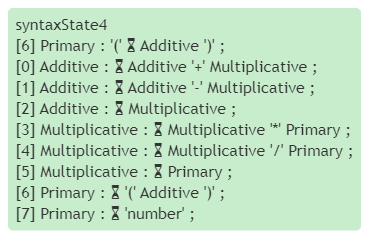
syntaxState4
[6] Primary : '(' ⏳ Additive ')' ;
[0] Additive : ⏳ Additive '+' Multiplicative ;
[1] Additive : ⏳ Additive '-' Multiplicative ;
[2] Additive : ⏳ Multiplicative ;
[3] Multiplicative : ⏳ Multiplicative '*' Primary ;
[4] Multiplicative : ⏳ Multiplicative '/' Primary ;
[5] Multiplicative : ⏳ Primary ;
[6] Primary : ⏳ '(' Additive ')' ;
[7] Primary : ⏳ 'number' ;
如果語法分析器讀入的第一個Token是'number',那麼可以立即斷定,應當選擇R[7]展開/推導。此時,我將移進到Primary : 'number' ⏳ ;中的⏳處。注意,此處是R[7]的末尾,也就是說,實際上我們已經讀入了這個R[7]對應的全部Vt,那麼此時就應當用R[7]進行規約(Reduction)了,也就是說,應當建造這樣的樹結構:
R[7]=Primary : 'number' ; T[0]
└─T[0]='number' 46
剛剛,我直接面對的是'number';現在,我直接面對的是它的上級Primary。當syntaxState0遇到Primary時,[5] Multiplicative : ⏳ Primary ;這一放大級別訴我們,應當跳入(Goto)Multiplicative : Primary ⏳ ;這個狀態。
繼續求閉包,繼續移進/規約,直至沒有新的syntaxState出現,LR(0)分析法的語法分析表就形成了,如下圖所示。這個過程就是LR(0)分析表的構造演演算法。
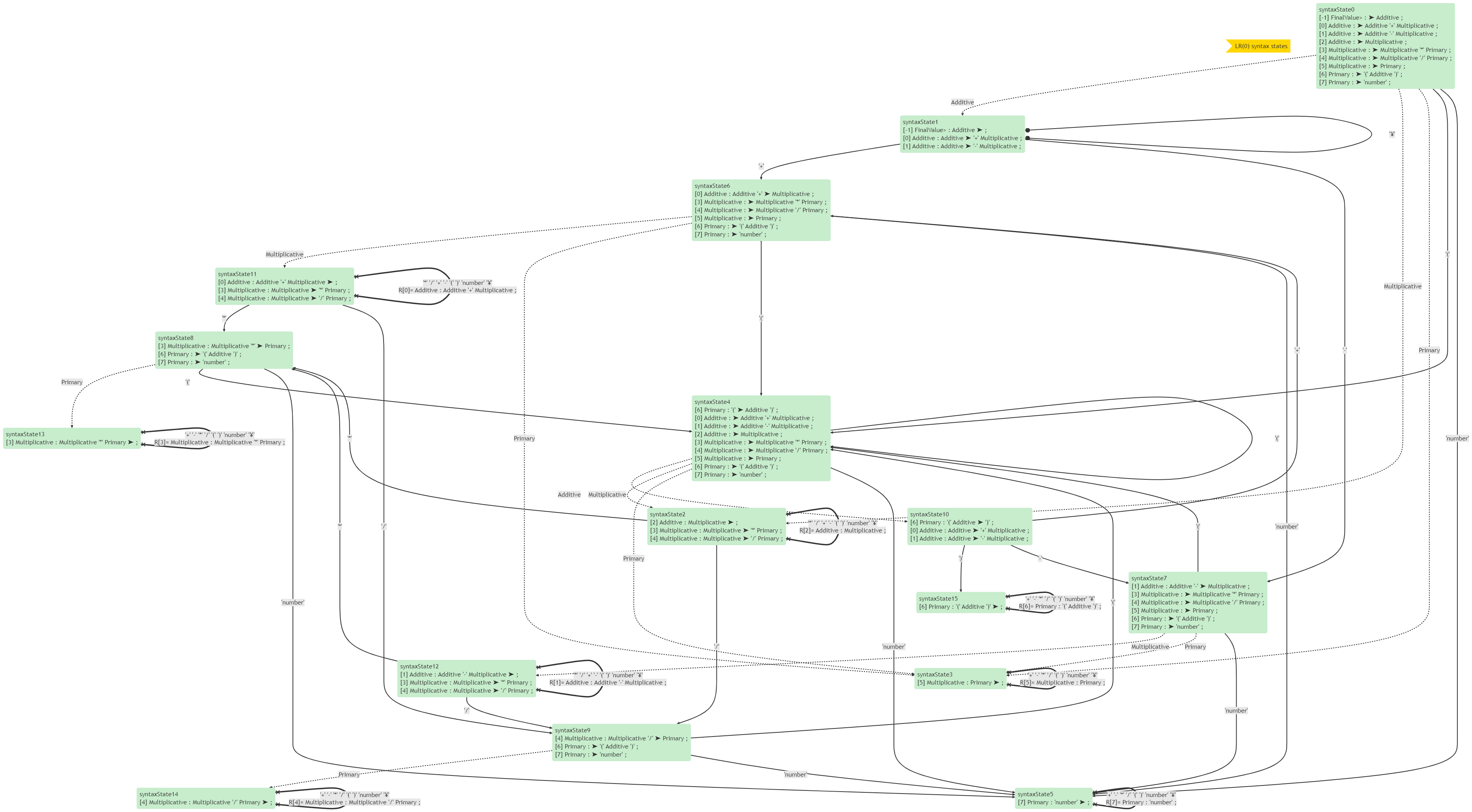
也可以用表格表示:
| 狀態 | '+' | '-' | '*' | '/' | '(' | ')' | 'number' | '¥' | Additive | Multiplicative | Primary |
|---|---|---|---|---|---|---|---|---|---|---|---|
| 0 | S4 | S5 | G1 | G2 | G3 | ||||||
| 1 | S6 | S7 | 完成 | ||||||||
| 2 | R[2] | R[2] | S8 R[2] | S9 R[2] | R[2] | R[2] | R[2] | R[2] | |||
| 3 | R[5] | R[5] | R[5] | R[5] | R[5] | R[5] | R[5] | R[5] | |||
| 4 | S4 | S5 | G10 | G2 | G3 | ||||||
| 5 | R[7] | R[7] | R[7] | R[7] | R[7] | R[7] | R[7] | R[7] | |||
| 6 | S4 | S5 | G11 | G3 | |||||||
| 7 | S4 | S5 | G12 | G3 | |||||||
| 8 | S4 | S5 | G13 | ||||||||
| 9 | S4 | S5 | G14 | ||||||||
| 10 | S6 | S7 | S15 | ||||||||
| 11 | R[0] | R[0] | S8 R[0] | S9 R[0] | R[0] | R[0] | R[0] | R[0] | |||
| 12 | R[1] | R[1] | S8 R[1] | S9 R[1] | R[1] | R[1] | R[1] | R[1] | |||
| 13 | R[3] | R[3] | R[3] | R[3] | R[3] | R[3] | R[3] | R[3] | |||
| 14 | R[4] | R[4] | R[4] | R[4] | R[4] | R[4] | R[4] | R[4] | |||
| 15 | R[6] | R[6] | R[6] | R[6] | R[6] | R[6] | R[6] | R[6] |
其中的第一行0和列'('對應的內容為S4,表示在狀態0讀到'('型別的Vt時,應當移進並進入狀態4。
其中的第一行0和列Additive對應的內容為G1,表示在狀態0遇到Additive型別的Vn時,應當跳入狀態1。
其中的第三行2和列'+'對應的內容為R[2],表示在狀態2遇到'+'型別的Vt時,應當用R[2]規約。
其中的列'¥'表示額外的結束符,其作用類似詞法分析中最後額外新增的檔案結束符'\0'。讀到此Vt就表示整個TokenList已讀完。
從表格中可以看到,有的狀態下,既可以移進,也可以規約。這是語法衝突。這說明Calc不能用LR(0)分析法。
例如,用Calc解析123+456*789:
讀入'number':從狀態0移進到狀態5;
狀態5規約:Primary : 'number' ;,回到狀態0;
從狀態0跳入狀態3;
狀態3規約:Multiplicative : Primary ;,回到狀態0;
從狀態0跳入狀態2;
狀態2規約:Additive : Multiplicative ;,回到狀態0;
從狀態0跳入狀態1;
讀入'+':從狀態1移進到狀態6;
讀入'number':從狀態6移進到狀態5;
狀態5規約:Primary : 'number' ;,回到狀態6;
從狀態6跳入狀態3;
狀態3規約:Multiplicative : Primary ;,回到狀態6;
從狀態6跳入狀態11;★★★
讀入'*':從狀態11移進到狀態8;
讀入'number':從狀態8移進到狀態5;
狀態5規約:Primary : 'number' ;,回到狀態8;
從狀態8跳入狀態13
狀態13規約:Multiplicative : Multiplicative '*' Primary ;,回到狀態6;
從狀態6跳入狀態11
狀態11規約:Additive : Additive '+' Multiplicative ;,回到狀態0;
從狀態0跳入狀態1
完成,回到狀態0
注意上面標★★★的位置,狀態11應當移進下一個Vt呢還是規約成Additive並回到狀態0呢?
如果規約,那麼就是先計算123+456後與789相乘了,其含義就變成了(123+456)*789。作為人類,我們知道此時應當移進;但作為計算機,它是沒有這種認知的。計算機是沒有任何認知的。
有衝突的位置不止這一個,讀者可以自行尋找。
讀者可以嘗試下面的例子,看看能否用LR(0)分析法。適量的練習是快速理解複雜內容的不二法門。
A : A '+' B // [0]
| 'a' ; // [1]
B : 'b' ; // [2]
完成練習後,可以在(https://www.cnblogs.com/bitzhuwei/p/ABB-readme-full.html)檢視答案。
SLR(1)分析法
繼續上面的例子,如果456後面跟的是'*',那麼就應當移進,如果是'+',那麼就應當規約。
理論化地說,在Calc文法中,當⏳位於Additive : Additive '+' Multiplicative ⏳ ;狀態,只有⏳後面緊跟的是FOLLOW(Addtive)中的Token型別時,才有可能「狀態11應當用R[0]規約」,否則就不可能。
這就是SLR(1)的核心思想,也是SLR(1)與LR(0)的唯一區別。S代表simple。
這樣,就可以減少一些R[n]的出現。Calc文法的SLR(1)分析表如下:
| 狀態 | '+' | '-' | '*' | '/' | '(' | ')' | 'number' | '¥' | Additive | Multiplicative | Primary |
|---|---|---|---|---|---|---|---|---|---|---|---|
| 0 | S4 | S5 | G1 | G2 | G3 | ||||||
| 1 | S6 | S7 | 完成 | ||||||||
| 2 | R[2] | R[2] | S8 | S9 | R[2] | R[2] | |||||
| 3 | R[5] | R[5] | R[5] | R[5] | R[5] | ||||||
| 4 | S4 | S5 | G10 | G2 | G3 | ||||||
| 5 | R[7] | R[7] | R[7] | R[7] | R[7] | ||||||
| 6 | S4 | S5 | G11 | G3 | |||||||
| 7 | S4 | S5 | G12 | G3 | |||||||
| 8 | S4 | S5 | G13 | ||||||||
| 9 | S4 | S5 | G14 | ||||||||
| 10 | S6 | S7 | S15 | ||||||||
| 11 | R[0] | R[0] | S8 | S9 | R[0] | R[0] | |||||
| 12 | R[1] | R[1] | S8 | S9 | R[1] | R[1] | |||||
| 13 | R[3] | R[3] | R[3] | R[3] | R[3] | ||||||
| 14 | R[4] | R[4] | R[4] | R[4] | R[4] | ||||||
| 15 | R[6] | R[6] | R[6] | R[6] | R[6] |
可以發現,此表中沒有衝突了。這說明Calc是可以用SLR(1)方法分析的。
LR(1)分析法
對於下面的文法,SLR(1)分析表仍然有衝突:
// GrammarName = Assignment
// ExtractedType = Assignment2
S : L '=' R | R ;
L : '*' R | 'id' ;
R : L ;
這是描述C語言中常見的a = *p或*p = x或*p = **d語句的文法部分。
它的SLR(1)分析表如下:
| 狀態 | '=' | '*' | 'id' | '¥' | S | L | R |
|---|---|---|---|---|---|---|---|
| 0 | S4 | S5 | G1 | G2 | G3 | ||
| 1 | 完成 | ||||||
| 2 | S6 R[4] | ||||||
| 3 | R[1] | ||||||
| 4 | S4 | S5 | G8 | G7 | |||
| 5 | R[3] | ||||||
| 6 | S4 | S5 | G8 | G9 | |||
| 7 | R[2] | ||||||
| 8 | R[4] | ||||||
| 9 | R[0] |
如表所示,在狀態2遇到'='時,仍舊存在衝突。
它的狀態圖如下:
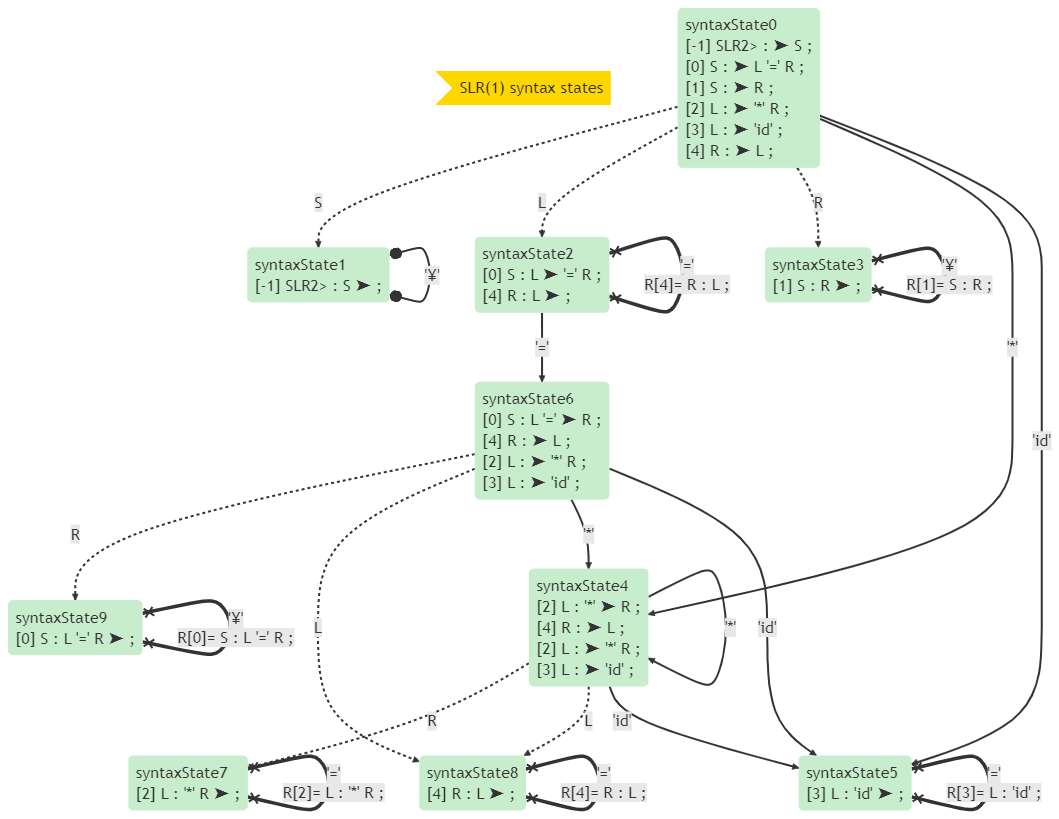
如圖所示,在狀態2遇到'='時,既可以按R[4]規約,又可以移進到狀態6。SLR(1)分析法無力解決這個衝突。
我們需要更細膩的分析法。
在認識LR(0)的閉包時,我們用放大鏡一級一級地展開⏳後面的Vn,但我們沒有管過:我們所在的Regulation對應的Vt串,緊跟著它的下一個Vt可能是什麼型別,可能是這個文法的所有Vt型別嗎?
當然不可能是。既然如此,我們應當在求解閉包的時候,把這個後面緊跟著的Token型別記錄下來。這個後面緊跟著的Token型別,被稱為lookAhead。這樣,當⏳位於某個Regulation的末尾,只有⏳後面是lookAhead時,才應當規約。
這就是LR(1)分析法的核心思想。在求解閉包時,除了像LR(0)一樣的操作外,還記錄了各個Regulation後面跟隨的Vt型別。這就是LR(1)與LR(0)的區別。
SLR(1)粗放地做了LR(1)的工作,因而適用範圍比LR(0)廣,比LR(1)窄。
上面的Assignment文法的LR(1)分析表如下:
| 狀態 | '=' | '*' | 'id' | '¥' | S | L | R |
|---|---|---|---|---|---|---|---|
| 0 | S4 | S5 | G1 | G2 | G3 | ||
| 1 | 完成 | ||||||
| 2 | S6 | R[4] | |||||
| 3 | R[1] | ||||||
| 4 | S4 | S5 | G8 | G7 | |||
| 5 | R[3] | R[3] | |||||
| 6 | S11 | S12 | G10 | G9 | |||
| 7 | R[2] | R[2] | |||||
| 8 | R[4] | R[4] | |||||
| 9 | R[0] | ||||||
| 10 | R[4] | ||||||
| 11 | S11 | S12 | G10 | G13 | |||
| 12 | R[3] | ||||||
| 13 | R[2] |
此表中就沒有衝突了,但狀態數量也增加了。它的狀態圖如下:
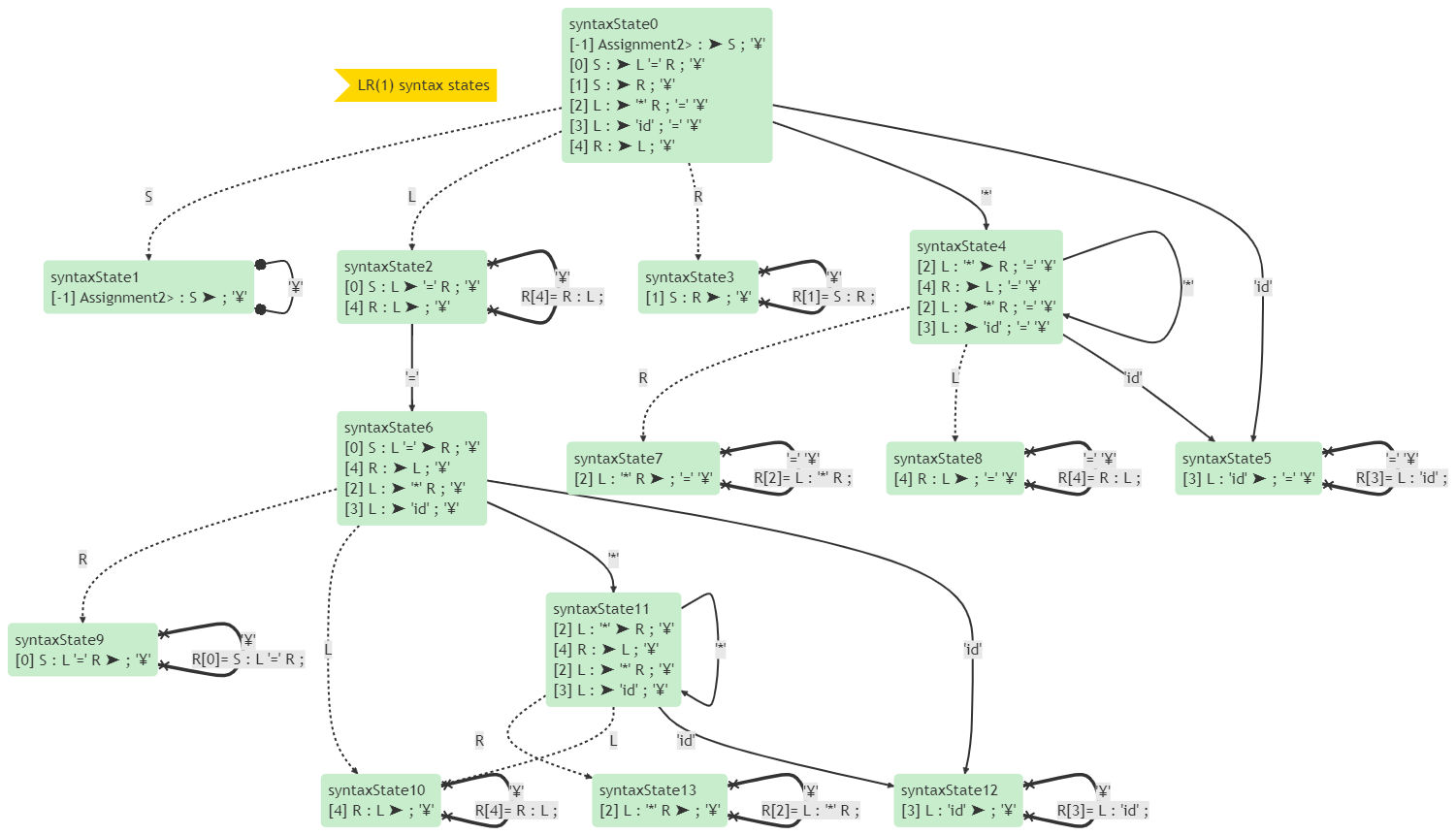
LR(1)分析法是我實現的適用範圍最廣的語法分析法。
LALR(1)分析法
LR(1)狀態的每個Item,都由Regulaiton、⏳的位置、跟隨的Vt(即lookAhead)這三條資料組成,其資訊詳盡,優點是適用範圍廣,缺點是它的狀態非常多,狀態包含的Item也非常多。在我處理GLSL Shader文法的時候,常常見到包含上萬個Item的LR(1)狀態。
兩個LR(1)狀態的Item,如果它們的Regulaiton相同、⏳的位置相同、只有lookAhead不同,我們也將這兩個Item視為相同。這就可以合併一些狀態。這樣,雖然在有的文法裡會產生衝突,但狀態的數量會大大減少。
這就是LALR(1)分析法的核心思想。很多程式語言,都可以用LALR(1)分析法進行語法分析。因此,它是很實用的優化技巧。
我們的Calc文法,可以用LALR(1)分析。它的LALR(1)分析表如下:
| 狀態 | '+' | '-' | '*' | '/' | '(' | ')' | 'number' | '¥' | Additive | Multiplicative | Primary |
|---|---|---|---|---|---|---|---|---|---|---|---|
| 0 | S4 | S5 | G1 | G2 | G3 | ||||||
| 1 | S6 | S7 | 完成 | ||||||||
| 2 | R[2] | R[2] | S8 | S9 | R[2] | R[2] | |||||
| 3 | R[5] | R[5] | R[5] | R[5] | R[5] | R[5] | |||||
| 4 | S4 | S5 | G10 | G2 | G3 | ||||||
| 5 | R[7] | R[7] | R[7] | R[7] | R[7] | R[7] | |||||
| 6 | S4 | S5 | G11 | G3 | |||||||
| 7 | S4 | S5 | G12 | G3 | |||||||
| 8 | S4 | S5 | G13 | ||||||||
| 9 | S4 | S5 | G14 | ||||||||
| 10 | S6 | S7 | S15 | ||||||||
| 11 | R[0] | R[0] | S8 | S9 | R[0] | R[0] | |||||
| 12 | R[1] | R[1] | S8 | S9 | R[1] | R[1] | |||||
| 13 | R[3] | R[3] | R[3] | R[3] | R[3] | R[3] | |||||
| 14 | R[4] | R[4] | R[4] | R[4] | R[4] | R[4] | |||||
| 15 | R[6] | R[6] | R[6] | R[6] | R[6] | R[6] |
它的LALR(1)狀態圖如下:
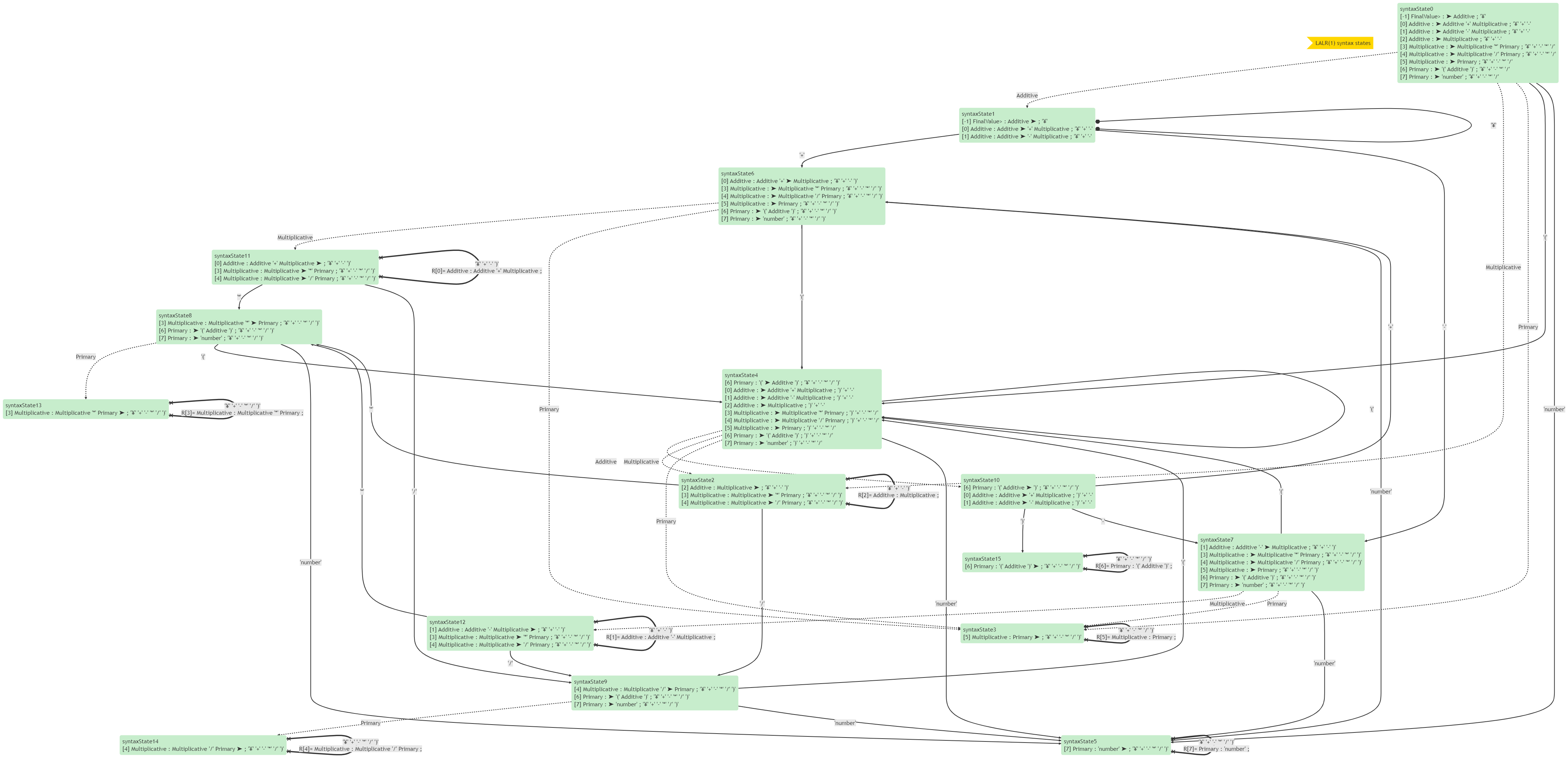
下面的文法用LALR(1)分析,就會產生衝突:
// GrammarName = LALR1Error
// ExtractedType = LALR1Error2
S : 'a' A 'd' | 'b' B 'd' | 'a' B 'e' | 'b' A 'e' ;
A : 'c' ;
B : 'c' ;
它的分析表如下:
| 狀態 | 'a' | 'd' | 'b' | 'e' | 'c' | '¥' | S | A | B |
|---|---|---|---|---|---|---|---|---|---|
| 0 | S2 | S3 | G1 | ||||||
| 1 | 完成 | ||||||||
| 2 | S6 | G4 | G5 | ||||||
| 3 | S6 | G8 | G7 | ||||||
| 4 | S9 | ||||||||
| 5 | S10 | ||||||||
| 6 | R[4] R[5] | R[5] R[4] | |||||||
| 7 | S11 | ||||||||
| 8 | S12 | ||||||||
| 9 | R[0] | ||||||||
| 10 | R[2] | ||||||||
| 11 | R[1] | ||||||||
| 12 | R[3] |
在分析表中可以看到,狀態6在遇到'd'或'e'時有衝突。
它的狀態圖如下:
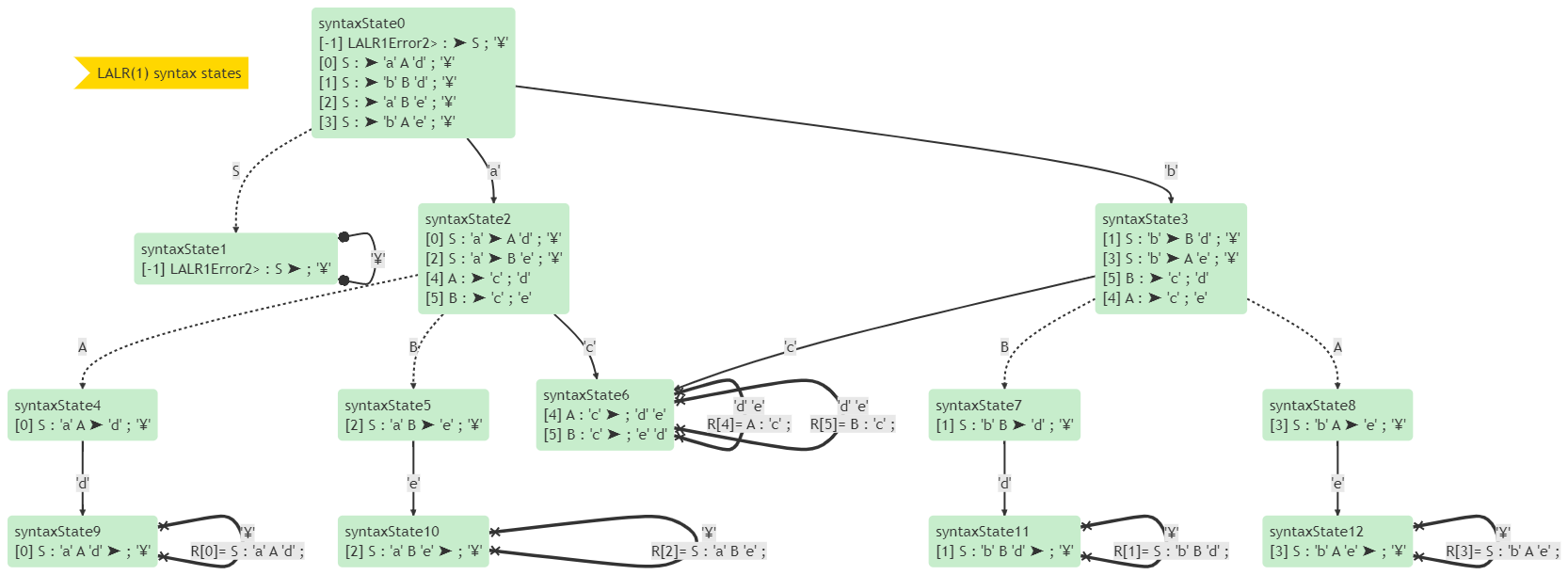
在狀態圖中也可以看到,狀態6在遇到'd'或'e'時可以按R[4]或R[5]進行規約。那到底是按R[4]規約還是按R[5]規約呢?它不知道呀。
LR分析法小結
從LR(0)到SLR(1)到LALR(1)到LR(1),能夠解析的文法範圍逐步擴大,每一個分析法能解析的文法,都是後一個的真子集。
Calc文法一鍵生成解析器相關的資料,可見於(https://www.cnblogs.com/bitzhuwei/p/Calc-readme-full.html)。
語意分析器
前文提過,如果按後序優先遍歷的方式過一遍語法樹,就可以得到依索引排列的TokenList。我們想知道46*(87-19)的算術結果是多少,這可以通過按後序優先遍歷的順序對各個V分別執行相應的操作來實現。相應的操作,反映到程式碼上,就是針對每種V都設計一個delegate。
每個Vt的操作都是一樣的:將它的Token入棧,供上級使用。
private static readonly Action<Node, TContext<FinalValue>> VtHandler =
(node, context) => {
var token = context.tokens[node.tokenIndex];
context.objStack.Push(token);
};
對Multiplicative : Multiplicative '*' Primary這個Regulation來說,棧裡會有3個物件,分別出棧,執行乘法計算,將結果入棧即可。其它Vn的思路相同,不再重述。
// 3: Multiplicative : Multiplicative '*' Primary ;
var primary0 = context.objStack.Pop() as Primary;
var asterisk1 = context.objStack.Pop() as Token;
var multiplicative2 = context.objStack.Pop() as Multiplicative;
var multiplicative = new Multiplicative(multiplicative2.value * primary0.value);
context.objStack.Push(multiplicative);
後序優先遍歷的遞迴版如下:
public void PostOrderRecursion(Node node)
{
for (int i = 0; i < node.Children.Count; i++)
{
PostOrderRecursion(node.Children[i]);
}
Visit(node);
}
private void Visit(Node node) {
// do something.
}
後序優先遍歷的非遞迴版如下:
public void PostOrder(Node rootNode) {
// post-order traverse rootNode with stack(without recursion).
var nodeStack = new Stack<Node>();
var indexStack = new Stack<int>();
// init stack.
{
// push nextLeft and its next pending children.
var nextLeft = rootNode;
nodeStack.Push(nextLeft); indexStack.Push(0);
while (nextLeft.Children.Count > 0) {
nextLeft = nextLeft.Children[0];
nodeStack.Push(nextLeft);
indexStack.Push(0);
}
}
while (nodeStack.Count > 0) {
var current = nodeStack.Pop();
var index = indexStack.Pop() + 1;
if (index < current.Children.Count) {
// push this node back again.
nodeStack.Push(current); indexStack.Push(index);
// push nextLeft and its next pending children.
var nextLeft = current.Children[index];
nodeStack.Push(nextLeft); indexStack.Push(0);
while (nextLeft.Children.Count > 0) {
nextLeft = nextLeft.Children[0];
nodeStack.Push(nextLeft);
indexStack.Push(0);
}
}
else {
Visit(current);
}
}
}
private void Visit(Node node) {
// do something.
}
其它
手工編寫詞法分析器和語法分析器是簡單而枯燥的。如果文法比較複雜,那麼工作量也會大增,很容易寫錯。下面我們來實現解析器的一鍵生成功能。
讀者可以預先看看Calc一鍵生成的各種資料結構(nullable、FIRST、FOLLOW、詞法分析表、語法分析表等)(https://www.cnblogs.com/bitzhuwei/p/Calc-readme-full.html)。
進入正題——文法解析器CompilerGrammar
讀者可在下述連結(https://www.cnblogs.com/bitzhuwei/p/some-grammars.html)中找到一些文法的例子。
經過一些練習,我們可以用文法來描述文法:
// GrammarName = Grammar
// ExtractedType = GrammarDraft
StatementList : StatementList Statement | Statement ;
Statement : SyntaxProduction | LexiProduction ;
SyntaxProduction : 'Vn' ':' CandidateList ';' ;
CandidateList : CandidateList '|' Candidate | Candidate ;
Candidate : VList | 'empty' ;
VList : VList V | V ;
V : 'Vn' | 'Vt' ;
LexiProduction : 'Vt' ':' 'pattern' ';' ;
// 3 VtPatterns:
'Vn' : %%[a-zA-Z_][a-zA-Z0-9_]*%% ;
'Vt' : %%'([ -&]|\\'|[(-\[]|\\\\|[\]-~])+'%% ;
'pattern' : %%[%]{2}[ -~]([^%]|%[^%])*[%]{2}%% ;
我們可以照葫蘆畫瓢,藉助寫CompilerCalc的經驗,得到Grammar的資料結構GrammarDraft。對GrammarDraft進行一系列演演算法操作,就可以得到任意文法的解析器了。
一鍵生成詞法分析器
詞法分析器,需要生成的是自動機對應的程式碼。自動機在文法中是用%%xxx%%裡的正規表示式描述的。我們要做的,就是把string格式的正規表示式,轉化為Automaton資料結構,最後轉化為C#程式碼。
正規表示式也是一門程式語言,應當用文法描述和解析。這裡需要解析的正規表示式格式如下:
// something(xxx) between %%xxx%%
// GrammarName=Pattern
// ExtractedType=TokenDraft
// VnRegulations:
Pattern : PreRegex Regex PostRegex ;
PreRegex : 'refVt' | empty ;
PostRegex : '/' Regex | empty ;
Regex : Regex '|' Bunch | Bunch;
Bunch : Bunch Unit | Unit ;
Unit : 'char' Repeat | '.' Repeat | 'scope' Repeat | '(' Regex ')' Repeat ;
Repeat : '?' | '+' | '*' | '{' 'min' UpperBound '}' | empty ;
UpperBound : ',' 'max' | ',' | empty ;
// VtRegex:
'refVt' : %%\<'([ -&]|\\'|[(-\[]|\\\\|[\]-~])+'\>%% ; // start with <' and end with '>
'min' : %%<'{'>[0-9]+%% ;
'max' : %%<','>[0-9]+%% ;
// 'char' is a letter or an escape
'char' : %%[ !"#%&',]|-|[0-9:;<=>@A-Z_`a-z~]|\\[$()*+]|\\-|\\[./<>?]|\\\[|\\\\|\\\]|\\\^|\\\{|\\\||\\\}|\\u[0-9a-fA-F]{4}%% ;
//'scope' : %%\[((firstLetter1)(char)*|\^(firstLetter2)(char)*)\]%% ; // a-z or A-Z or ...
//firstLetter1 = \\u[0-9]{4}|\\t|\\n|\\r|\\-|[ -Z]|\[|\\\\|]|\\\^|[_-~]
//firstLetter2 = \\u[0-9]{4}|\\t|\\n|\\r|\\-|[ -Z]|\[|\\\\|]|\^|\\\^|[_-~]
//char = \\u[0-9]{4}|\\t|\\n|\\r|\\-|[ -Z]|\\\[|\\\\|\\\]|\^|\\\^|[_-~]
'scope' : %%\[((\\u[0-9]{4}|\\t|\\n|\\r|\\-|[ -Z]|\[|\\\\|]|\\\^|[_-~])(\\u[0-9]{4}|\\t|\\n|\\r|\\-|[ -Z]|\\\[|\\\\|\\\]|\^|\\\^|[_-~])*|\^(\\u[0-9]{4}|\\t|\\n|\\r|\\-|[ -Z]|\[|\\\\|]|\^|\\\^|[_-~])(\\u[0-9]{4}|\\t|\\n|\\r|\\-|[ -Z]|\\\[|\\\\|\\\]|\^|\\\^|[_-~])*)\]%% ; // a-z or A-Z or ...
這個文法看起來嚇人,實際上用手工實現也不困難,只是需要耐心和細心。
Lex用字首和字尾增強了描述自動機的能力,它使用的已經不是純粹的正規表示式(regex)了,而是<'xxx'>regex/post-regex。因此,我將此文法稱為Pattern而不是Regex。我認為這個增強的功能很有必要,且其實現並不特別困難,所以這裡也實現了它。
字首<'xxx'>
字首能起到這樣的作用:在識別了一個'xxx'型別的Token後,應當將後續的regex認定為某個型別。
例如,'min' : %%<'{'>[0-9]+%% ;的意思是,在識別了一個'{'後,應當將後續的數值認定為一個'min'。而'max' : %%<','>[0-9]+%% ;的意思是,在識別了一個','後,應當將後續的數值認定為一個'max'。這樣,同樣的內容就能夠在不同的字首下被認定為不同的型別了。這大大有利於後續的語法分析。
此功能的實現,就是將[0-9]+的自動機的開頭連結到'{'或','的自動機的末尾。
字尾/post-regex
字尾能起到這樣的作用:在識別了一個post-regex之後,才將'/'前面的regex認定為某個型別。
例如,下述文法:
Item : 'entityId' '=' 'refEntity' ;
'entityId' : %%[A-Za-z_][A-Za-z0-9_]*/=%% ;
'refEntity' : %%[A-Za-z_][A-Za-z0-9_]*%% ;
只有識別了一個'='的時候,才會將前面的識別符號認定為'entityId'。也就是說,像平時一樣記錄Token的起始位置和長度,但直到讀到了'='才設定Token的型別。
此功能的實現,就是將post-regex(/後面的regex)連結到regex末尾。
從string到Automaton,需要經歷string => ε-NFA => NFA => DFA => MiniDFA的過程。
ε-NFA
為了連結regex內部和外部各種結構,我們先用空ε邊把它們連結起來。空ε邊就是不需要讀入任何char就可以跳轉過去的邊。有空ε邊的自動機,我們稱為ε-NFA。
Calc文法的ε-NFA如下圖所示:
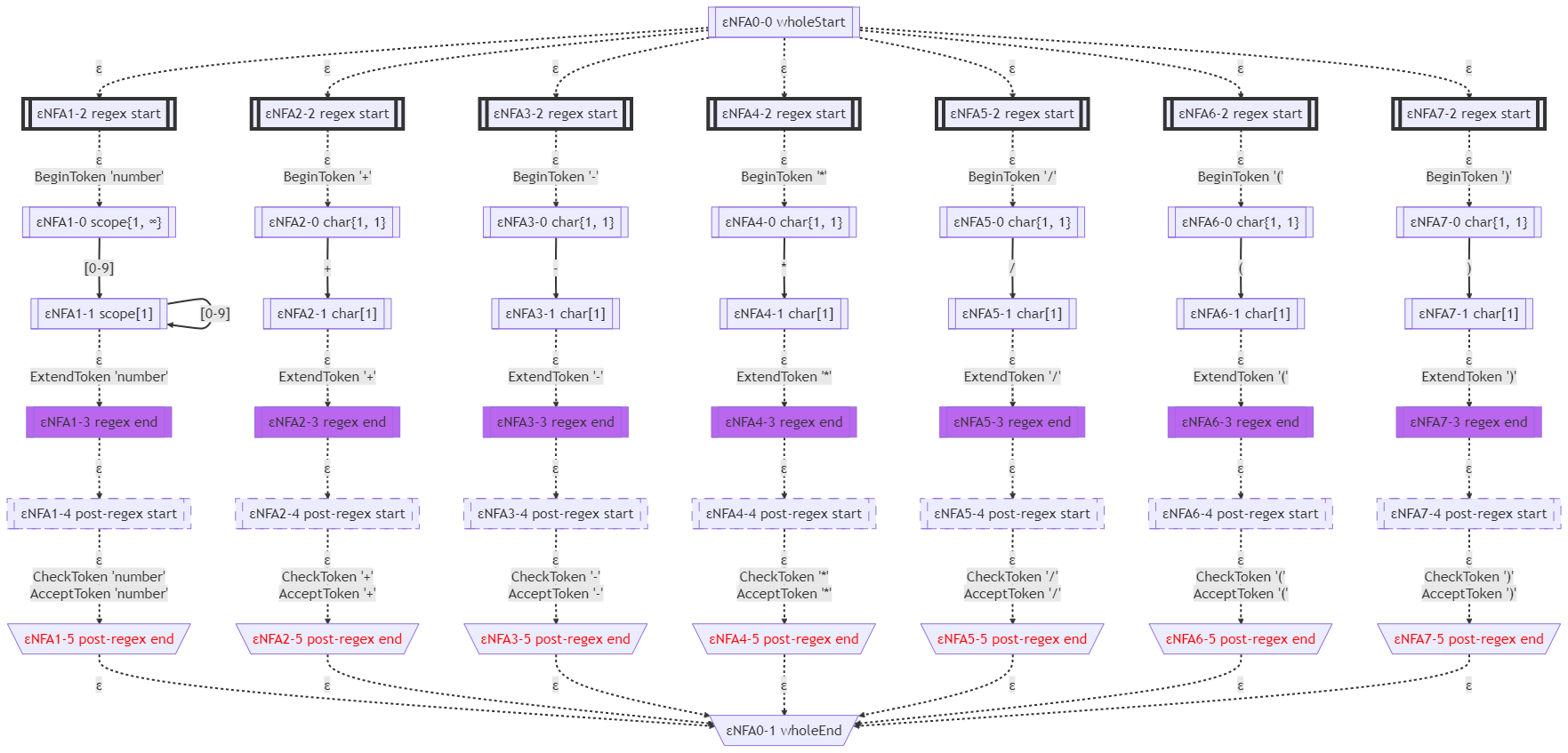
NFA
現在,我們設法去掉空ε邊,也就是將ε-NFA轉換為NFA。

演演算法思想如下:如上圖所示,A可以通過空ε邊到達B,B可以通過'x'到達C。這說明,A也可以通過'x'到達C。也就是說,隱含著一條A-'x'->C的邊。
我們將此邊建立起來,使它不再隱式存在,而是顯式存在。
這樣,就不需要繼續保持原來的空ε邊了。因為空ε邊的意義,就是隱式的表明A-'x'->C邊的存在,再無其他。
為了去掉空ε邊,我們只需遍歷此圖的各個結點N,當從N走出去的邊為空ε邊時,直接忽略它,不去遍歷它指向的結點。這樣,將全部被遍歷到的結點及其非空ε邊收集起來,就是不含空ε邊的NFA了。
將Calc文法的ε-NFA隱含的邊都顯示出來,如下圖所示:

將Calc文法的ε-NFA的空ε邊都去掉,得到的NFA如下圖所示:

DFA
如果既需要識別整數[0-9]+,又需要識別浮點數[0-9]+[.][0-9]+,那麼當詞法分析器讀入的char是[0-9]中的一個時,就無法判斷接下來會遇到的是什麼型別的Token了,這怎麼辦?
理論化的說,如果一個自動機裡的狀態A,存在A-'x'->C和A-'x'->D這樣的兩個邊,那麼,狀態A讀到'x'時,就不知道該跳轉到狀態C還是狀態D了。
將NFA轉化為DFA,就是為了去掉這樣的邊。不含這樣的邊的NFA,就成了DFA。這個過程被稱為確定化。
演演算法(子集法)思想如下:
-
假設,
狀態A,存在A-'x'->C和A-'x'->D這樣的兩個邊。那好,狀態A構成一個新狀態X{A},狀態C和狀態D合起來構成一個新狀態Y{C,D},X{A}-'x'->Y{C,D}。我們可以說狀態C和狀態D組成了一個小家庭,住進了它們的小房子Y{C,D},它們共用一切;狀態A是單身漢,自己住一套小房子X{A}。狀態C和狀態D的任何邊,都是Y{C,D}的邊,都是這個小家庭的邊。狀態A的任何邊,都是X{A}的邊,都是這個獨居戶的邊。 -
繼續假設,
狀態A,存在A-'t'->D和A-'t'->E這樣的兩個邊。類似上一步,狀態A組成新狀態X{A},狀態D和狀態E合起來構成一個新狀態Z{D,E},X{A}-'t'->Z{D,E}。我們可以說狀態D和狀態E組成了一個小家庭,住進了它們的小房子Z{D,E},它們共用一切;狀態A是單身漢,自己住一套小房子X{A}。狀態D和狀態E的任何邊,都是Z{D,E}的邊,都是這個小家庭的邊。狀態A的任何邊,都是X{A}的邊,都是這個獨居戶的邊。 -
注意,
狀態D同時參與了小房子Y{C,D}和小房子Z{D,E}的構建,它腳踏兩隻船。在人間,這是被批判的;在自動機,這是很普遍的,而且是可以腳踏好多船的。 -
全部小房子就是DFA的狀態,小房子之間的邊就是DFA狀態的邊。
一個小房子裡,任何一個NFA狀態都可能住進去,也可能不住進去,僅此兩種可能。如果NFA有10個狀態,那麼,可能的小家庭就有2^10-1=1023種(10個人都不住進去,就空了)。這說明,從有n個狀態的NFA轉換為DFA,此DFA最多可能有2^n-1個狀態。
Calc文法的DFA如下圖所示:

可見,每個DFA小房子裡都只有1個NFA。如果不如此詳細地繪製包含的NFA,那麼DFA如下圖所示:

如果每個DFA小房子裡都只有1個NFA,說明那個NFA本身就已經是DFA了。
為了直觀展示NFA與DFA的區別,這裡再舉一個文法的例子:
// GrammarName = Scope
// ExtractedType = ResolvedScope
Scope : '[' 'firstItem1' RangeItems ']' ;
Scope : '[^' 'firstItem2' RangeItems ']' ;
Scope : '[' 'firstItem1' ']' ;
Scope : '[^' 'firstItem2' ']' ;
RangeItems : RangeItems RangeItem | RangeItem ;
RangeItem : 'char' ;
// \uNNNN \t \n \r 口 ! " # $ % & '
// ( ) * + , - . /
// 0 1 2 3 4 5 6 7 8 9
// : ; < = > ? @
// A B C D E F G H I J K L M
// N O P Q R S T U V W X Y Z
// [ \ ] ^ _ `
// a b c d e f g h i j k l m
// n o p q r s t u v w x y z
// { | } ~
// escape: \ ^
'firstItem1' : %%<'['>\\u[0-9]{4}|\\t|\\n|\\r|\\-|[ -Z]|\[|\\\\|]|\\\^|[_-~]%% ;
// escape: \
'firstItem2' : %%<'[^'>\\u[0-9]{4}|\\t|\\n|\\r|\\-|[ -Z]|\[|\\\\|]|\^|\\\^|[_-~]%% ;
// escape: [ \ ]
'char' : %%\\u[0-9]{4}|\\t|\\n|\\r|\\-|[ -Z]|\\\[|\\\\|\\\]|\^|\\\^|[_-~]%% ;
這個Scope文法,是為了解析正規表示式中的[xxx]結構而作的。當然,我們可以把這個文法融入Pattern文法中,還可以再把Pattern文法融入Grammar文法中。但那樣的文法太龐大,不易維護。
讀者可以在(https://www.cnblogs.com/bitzhuwei/p/Scope-readme-full.html)瀏覽直接用Mermaid展示的詳情。
這個Scope文法的ε-NFA如下圖所示:

由於顯式的ε-NFA太龐大,Mermaid渲染器拒絕了渲染:

這個Scope文法的NFA如下圖所示:

這個Scope文法的DFA如下圖所示:
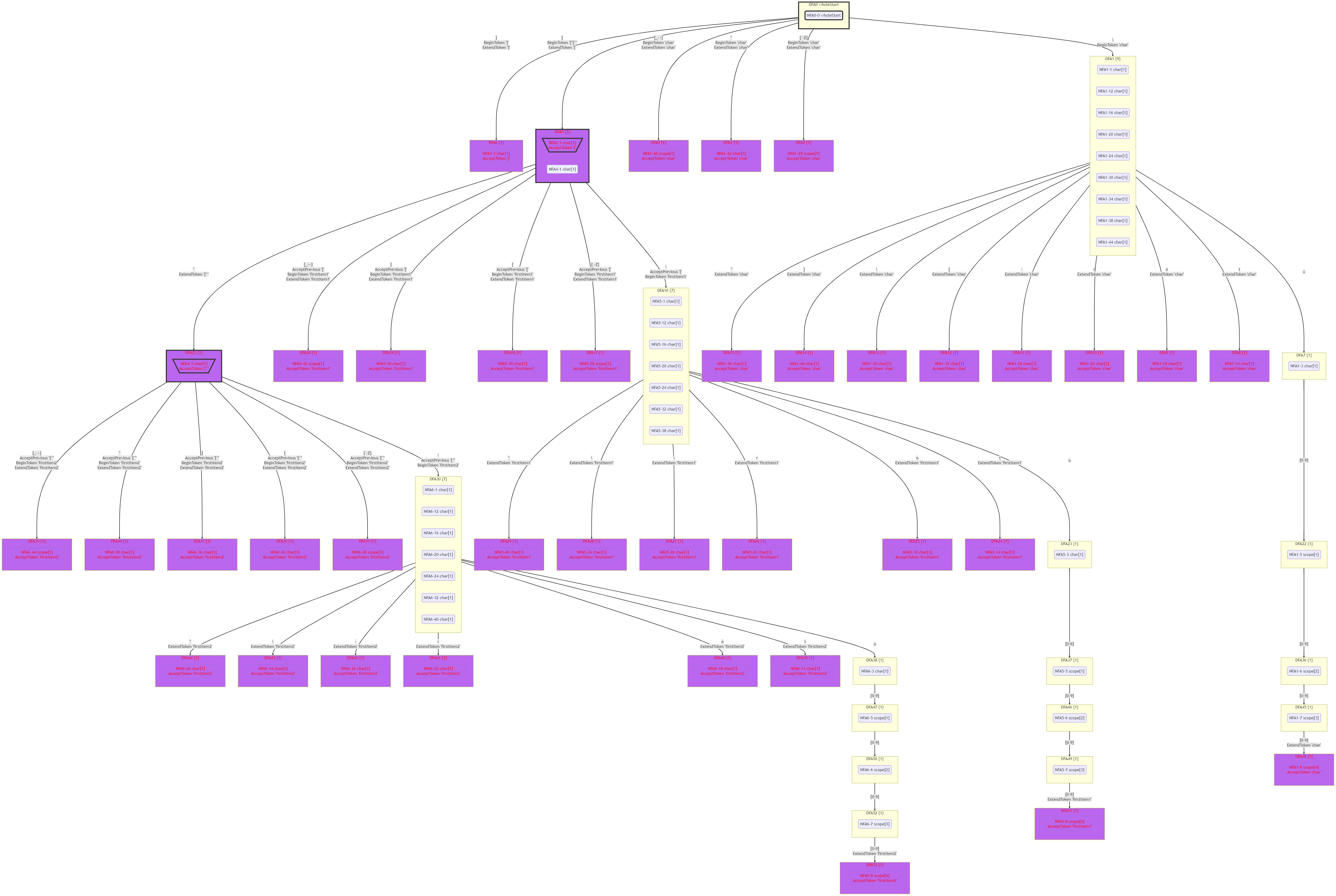
可見,有的DFA小房子裡包含多個NFA狀態。會出現這種情況,是因為存在[和[^這樣的含有相同的開頭的Token型別。可惜這個例子裡沒有出現腳踏兩隻船的情況。
這個Scope文法的DFA(簡化顯示)如下圖所示:

下面這個文法的DFA裡出現了腳踏兩隻船的情況:
// 1 VnRegulations:
PreRegex : 'refVt' ; // [0]
// 1 VtPatterns:
'refVt' : %%(\\|[Y-\\])+%% ; // [0]
這個文法實際上是Pattern的一小部分,當時的'refVt'我寫錯了,卻恰好見到了腳踏兩隻船的情況。
這個文法的ε-NFA如下圖所示:

這個文法的顯式的ε-NFA如下圖所示:
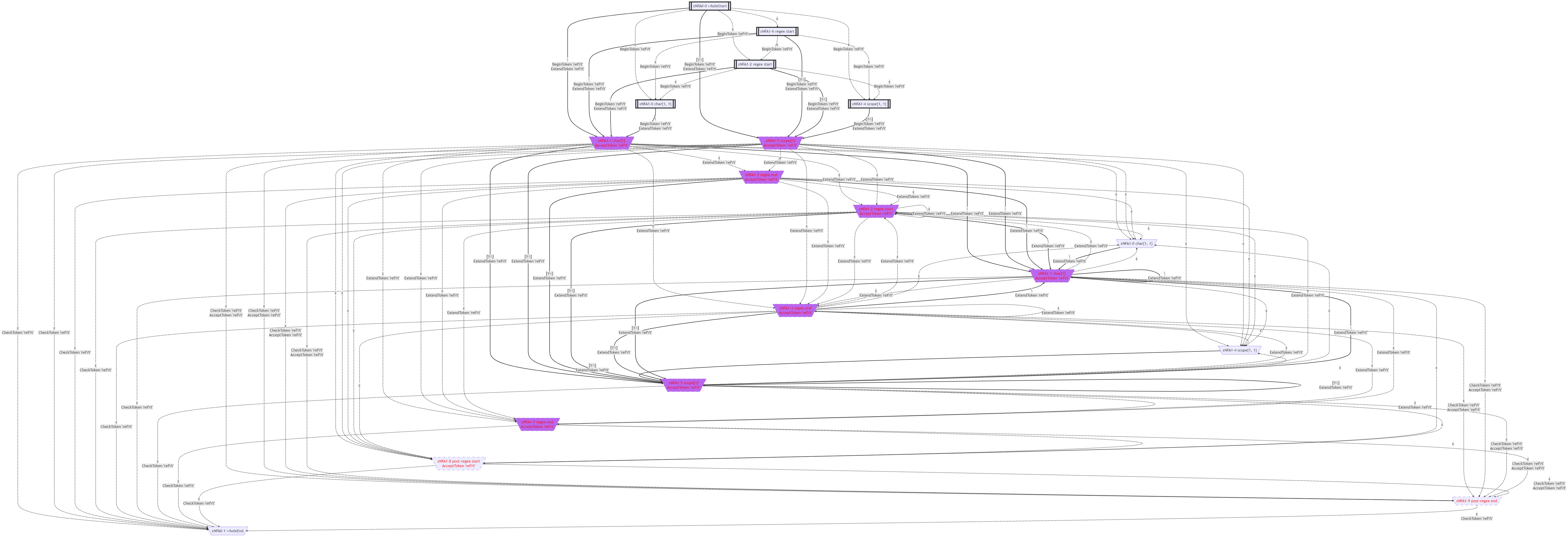
這個文法的NFA如下圖所示:
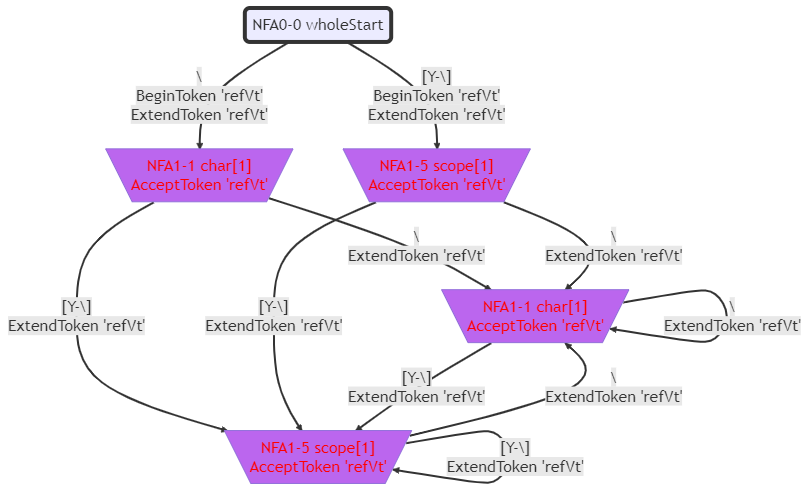
這個文法的DFA如下圖所示:
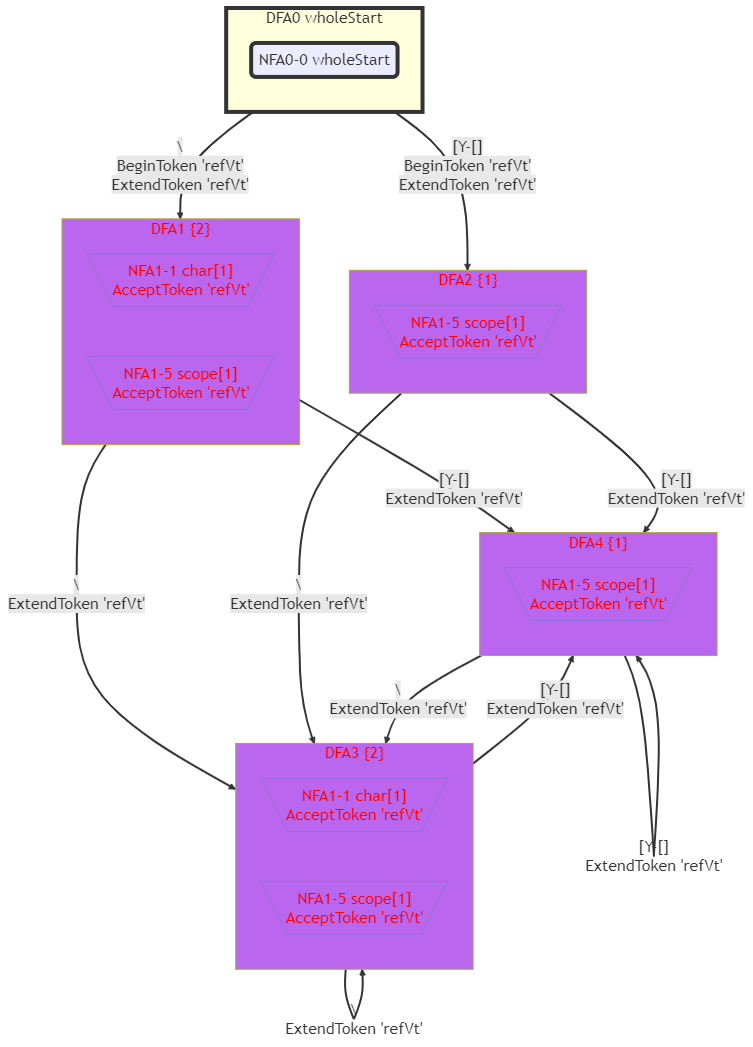
MiniDFA
有了DFA,就可以將其轉換為C#程式碼了。但DFA還有減少狀態的可能。將DFA的狀態減至最少,它轉換出的C#程式碼也會佔用更少的記憶體,有利於提升效率。這種可能的最少狀態的DFA,我們稱為MiniDFA。
演演算法(Hopcroft)思想如下:
-
將終態放到同一個小房子(集合),非終態放到另一個小房子(集合)。哪些是終態呢?能夠認定一個
Token的狀態,就是終態,否則就是非終態。 -
同一個小房子裡的
DFA狀態A和DFA狀態B,如果它們在經過某個'x'時,DFA狀態A指向了一個小房子,DFA狀態B指向了另一個小房子,就說明它們不等價,它們應當被放到不同的小房子裡;如果它們在經過ASCII碼中每一個char時,指向的小房子都相同,就說明它們等價,它們應當被放到相同的小房子裡。例如,如果它們在經過'\0'-'P'這些char時,都指向小房子M;它們在經過'Q'-'~'這些char時,都指向小房子N,就說明它們等價。 -
所有的小房子構成
MiniDFA狀態,小房子中各個DFA狀態之間的邊就是MiniDFA狀態的邊。
MiniDFA的小房子與DFA的小房子不同:一個DFA狀態,只會住進一個MiniDFA的小房子裡,不會出現腳踩兩隻船的情況。
Calc文法的MiniDFA如下圖所示:

如果不詳細地顯示包含的DFA,那麼MiniDFA如下圖所示:

MiniDFA在Calc文法中沒有顯示出明顯的作用。在Pattern文法中,它能夠將詞法分析器狀態從611個DFA狀態降低到86個MiniDFA狀態。
一鍵生成語法分析器
上文運用LL(1)、LR(0)、SLR(1)、LALR(1)、LR(1)分析法的過程,就是手工執行演演算法的過程。將此過程整理成程式碼,就是一鍵生成語法分析器的功能。
計算nullable(VList)
演演算法思想:
-
全部
Vt都是不可空的,即nullable(Vt)=false。 -
先假設全部
Vn也都是不可空的,即nullable(Vn)=false。 -
如果有
Vn : empty ;這樣的Regulation,那麼nullable(Vn)=true。 -
對於
Vn : V1 V2 V3 .. ;這樣的Regulation,如果nullable(V1 V2 V3 ..)=true,那麼nullable(Vn)=true。 -
迭代到不動點。
public static Dictionary<string, bool> GetNullableDict(this VnRegulationDraft[] vnRegulations) {
var nullableDict = new Dictionary<string/*Node.type*/, bool>();
// allocate space for all kinds of nodes(Vt and Vn, no empty).
var allNodeTypes = vnRegulations.GetNodes();
foreach (var item in allNodeTypes) {
nullableDict.Add(item, false);
}
nullableDict.Add(string.Empty, true);
// iterate untill not changed.
bool changed = false;
do {
changed = false;
foreach (var regulation in vnRegulations) {
// 如果regulation.right可推匯出empty,就說明regulation.left可推匯出empty。
// if regulation.right can refer to 'empty',
// then regulation.left, too.
if (CanBeEmpty(regulation.Right, nullableDict)) {
var left = regulation.left;
if (!nullableDict[left]) {
nullableDict[left] = true;
changed = true;
}
}
}
} while (changed);
return nullableDict;
}
計算FIRST(VList)
演演算法思想:
-
對於全部
Vt都有:FIRST(Vt)={ Vt }。 -
對於全部
Vn都有:若nullable(Vn)=true,則FIRST(Vn)包含空ε。 -
對於
Vn : V1 V2 V3 .. ;這樣的Regulation:FIRST(Vn)包含FIRST(V1);若nullable(V1)=true,則FIRST(Vn)還包含FIRST(V2);若nullable(V1 V2)=true,則FIRST(Vn)還包含FIRST(V3);以此類推。 -
迭代到不動點。
private static Dictionary<string, FIRST> GetFIRSTDict4Node(this VnRegulationDraft[] regulations, Dictionary<string, bool> nullableDict) {
var result = new Dictionary<string/*V*/, FIRST>();
var empty = "empty"; /* ε */
// allocate space for all single nodes.
// 初始化FIRST(Vn)
foreach (var Vn in regulations.GetVnNodes()) {
if (nullableDict[Vn]) {
var first = new FIRST(Vn, empty);
result.Add(Vn, first);
}
else {
var first = new FIRST(Vn);
result.Add(Vn, first);
}
}
// 初始化FIRST(Vt)(FIRST(Vt)實際上已經完工)
foreach (var Vt in regulations.GetVtNodes()) {
var first = new FIRST(Vt, Vt);
result.Add(Vt, first);
}
bool changed = false;
do {
changed = false;
foreach (var regulation in regulations) {
var left = regulation.left; var right = regulation.Right;
// try to collect FIRST( left )
for (int checkpoint = 0; checkpoint < right.Count; checkpoint ++) {
// 如果前checkpoint個結點都可為null,
// 就說明 FIRST(left) 包含 FIRST(right[checkpoint]),empty除外。
// if regulation.right[(-1)->(checkpoint-1)] can be empty,
// then FIRST( left ) includes FIRST( right[checkpoint] )
// except for empty.
if (CanBeEmpty(right, 0, checkpoint, nullableDict)) {
var refKey = right[checkpoint];
if (left != refKey) {
if (!result.TryGetValue(left, out FIRST first)) { throw new Exception(algorithmError); }
if (!result.TryGetValue(refKey, out FIRST refFirst)) { throw new Exception(algorithmError); }
foreach (var value in refFirst.Values) {
if (value != empty) {
changed = first.TryInsert(value) || changed;
}
}
}
}
}
{
// if regulation.right can be empty,
// then regulation.left can be empty.
if (CanBeEmpty(right, nullableDict)) {
if (!result.TryGetValue(left, out FIRST first)) { throw new Exception(algorithmError); }
changed = first.TryInsert(empty) || changed;
}
}
}
} while (changed);
}
計算FOLLOW(Vn)
演演算法思想:
-
對於
left : 某V 某V .. Vn V1 V2 .. ;這樣的Regulation:FOLLOW(Vn)包含FIRST(V1);若
nullable(V1)=true,則FOLLOW(Vn)還包含FIRST(V2);以此類推;若
nullable(V1 V2 ..)=true,則FOLLOW(Vn)還包含FOLLOW(left)。 -
迭代到不動點。
public static Dictionary<string/*FOLLOW.target*/, FOLLOW> GetFOLLOWDict(this VnRegulationDraft[] regulations,
Dictionary<string, bool> nullableDict, Dictionary<string, FIRST> firstDict) {
var result = new Dictionary<string/*FOLLOW.Vn*/, FOLLOW>();
// 初始化Follow Dict
// allocate space for the FOLLOW( Vn ) items.
foreach (var item in regulations.GetVnNodes()) {
var follow = new FOLLOW(item);
result.Add(follow.Vn, follow);
}
// 迭代到不動點
// iterate untill not changed.
bool changed = false;
do {
changed = false;
foreach (var regulation in regulations) {
var right = regulation.Right; int count = right.Count;
for (int checkpoint = 0; checkpoint < count; checkpoint++) {
string/*Node.type*/ target = right[checkpoint];
if (target.IsVt()) { continue; } // 葉結點沒有FOLLOW
// 準備為target新增follow元素
// try to collect FOLLOW( target )
var checkIndex = checkpoint + 1;
for (int checkCount = 0; checkCount < count - checkIndex; checkCount++) {
// if right[checkIndex->(checkIndex+checkCount-1)] can be empty,
// then FOLLOW( target ) includes FIRST( right[checkInde+checkCount] )
// except empty.
if (CanBeEmpty(right, checkIndex, checkCount, nullableDict)) {
// FOLLOW( target ) 包含 FIRST( right[checkInde+checkCount] )(除了empty)
var Vn = target;
if (!result.TryGetValue(Vn, out FOLLOW follow)) { throw new Exception(algorithmError); }
string key = right[checkIndex + checkCount];
if (!firstDict.TryGetValue(key, out FIRST first)) { throw new Exception(algorithmError); }
foreach (var value in first.Values) {
if (value != "empty") {
changed = follow.TryInsert(value) || changed;
}
}
}
}
{
var checkCount = count - checkIndex;
// 如果target之後的全部結點都可為empty,那麼 FOLLOW( target ) 包含 FOLLOW( regulation.left )
// if right[checkIndex->(count - checkIndex-1)] can be empty,
// then FOLLOW( target ) includes FOLLOW( regulation.left ).
if (CanBeEmpty(right, checkIndex, checkCount, nullableDict)) {
if (!result.TryGetValue(target, out FOLLOW follow)) { throw new Exception(algorithmError); }
if (!result.TryGetValue(regulation.left, out FOLLOW refFollow)) { throw new Exception(algorithmError); }
if (follow != refFollow) {
foreach (var item in refFollow.Values) {
changed = follow.TryInsert(item) || changed;
}
}
}
}
}
}
} while (changed);
return result;
}
擴充套件文法
這是一個程式設計技巧:對任何文法,都在開頭新增一個S2結點,作為初始結點。這樣可以使得完成動作只存在1個。我將擴充套件的文法稱為eGrammar,其產生式部分稱為eRegulations,(e代表extended)額外新增的這個Regulation稱為擴充套件Regulation。
例如,擴充套件的四則運算Calc文法如下:
// GrammarName = Calc
// ExtractedType = FinalValue
S2 : Additive ;
Additive : Additive '+' Multiplicative // R[0]
| Additive '-' Multiplicative // R[1]
| Multiplicative ; // R[2]
Multiplicative : Multiplicative '*' Primary // R[3]
| Multiplicative '/' Primary // R[4]
| Primary ; // R[5]
Primary : '(' Additive ')' // R[6]
| 'number' ; // R[7]
// 用 %%xxx%% 格式 描述單詞
'number' : %%[0-9]+%% ; // 為便於演示,僅處理正整數
LL(1)分析法
演演算法思想:
-
對於
Vn : V1 V2 V3 .. ;這樣的Regulation:對於
FIRST(V1 V2 V3 ..)中的每個元素Vt(不含空ε),在LL(1)分析表中記錄下「Vn行Vt列對應Vn : V1 V2 V3 .. ;」,意為「在Vn狀態下遇到Vt時,應當使用Vn : V1 V2 V3 .. ;進行規約」;若
FIRST(V1 V2 V3 ..)包含空ε,則在LL(1)分析表中記錄下「Vn行全部FOLLOW(Vn)列對應Vn : V1 V2 V3 .. ;」,意為「在Vn狀態下遇到Vt時,應當使用Vn : V1 V2 V3 .. ;進行規約」。
public static LL1SyntaxInfo GetLL1SyntaxInfo(this VnRegulationDraft[] regulations,
VnRegulationDraft[] eRegulations,
Dictionary<string, FOLLOW> eFOLLOWDict, Dictionary<string, FIRST> eFIRSTDict) {
var regCount = regulations.Length;
var table = new LL1ParsingTableDraft();
for (int regulationId = 0; regulationId < regulations.Length; regulationId++) {
var regulation = regulations[regulationId];
var Vn = regulation.left;
var key = FIRST.MakeKey(regulation.Right);
var first = eFIRSTDict[key]; // FIRST( regulation.Right )
var firstCount = first.Values.Count;
for (int index = 0; index < firstCount; index++) {
var VtOrEmpty = first.Values[index];
if (VtOrEmpty != "empty" /* ε */) {
table.SetAction(Vn, VtOrEmpty, new LL1ParsingActionDraft(regulationId));
}
else {
var follow = eFOLLOWDict[Vn];
foreach (var Vt in follow.Values) {
table.SetAction(Vn, Vt, new LL1ParsingActionDraft(regulationId));
}
}
}
}
var result = new LL1SyntaxInfo(table);
return result;
}
LR(0)分析法
演演算法思想:
-
拿到第一個
Regulation(Vn:V1 V2 V3 .. ;),以Vn: ⏳ V1 V2 V3 .. ;為初始LR(0)狀態,並求解其閉包。實際上,第一個Regulation就是擴充套件Regulation。 -
對每個LR(0)狀態A,讓⏳向前移動一個
V,得到下一個LR(0)狀態B,並求解其閉包。 -
將
A-V->B設定為LR(0)邊。 -
設定LR(0)分析表:對每個LR(0)邊(例如
A-V->B),若V是Vt,則在A行V列記錄移進到B;若V是Vn,則在A行V列記錄跳入B。 -
設定LR(0)分析表:對每個LR(0)狀態(例如A)中的每個Item,若Item中的⏳位於
Regulation末尾,一般情況下,則在A行全部Vt列(包括'¥'列)記錄用Regulation規約;特殊情況(Regulation是擴充套件Regulation)下,則在A行'¥'列記錄完成。
public static LR0SyntaxInfo GetLR0SyntaxInfo(this VnRegulationDraft[] regulations,
VnRegulationDraft[] eRegulations) {
var stateList = new LR0StateList();
var edgeList = new LR0EdgeList();
var queue = new Queue<LR0State>(); {
var firstItem = LR0Item.GetItem(eRegulations[0], 0);
var firstState = new LR0State(firstItem); Closure(firstState, eRegulations);
stateList.TryInsert(firstState);
queue.Enqueue(firstState);
}
while (queue.Count > 0) {
var from = queue.Dequeue();
foreach (var item in from.Items) {
string/*Node.type*/ V = item.nodeNext2Dot;
if (V == null) { continue; }
var to = Goto(from, V); Closure(to, eRegulations);
if (stateList.TryInsert(to)) { // to是新狀態
queue.Enqueue(to);
var edge = new LR0Edge(from, V, to);
edgeList.TryInsert(edge);
}
else { // to是已有狀態
int t = stateList.IndexOf(to);
var oldTo = stateList.States[t];
var edge = new LR0Edge(from, V, to);
edgeList.TryInsert(edge);
}
}
}
var table = new LRParsingTableDraft();
foreach (var edge in edgeList.Edges) {
if (edge.V.IsVt()) {
// shift in action
table.SetAction(edge.from.index, edge.V, new LRShiftInActionDraft(edge.to.index));
}
else { // V is Vn
// goto action
table.SetAction(edge.from.index, edge.V, new LRGotoActionDraft(edge.to.index));
}
}
var Vts = eRegulations.GetVtNodes();
var eLeft = eRegulations[0].left; // the S' in many books.
var eEnd = '¥'; // similar to '\0' in lexical analyzing
foreach (var state in stateList.States) {
foreach (var item in state.Items) {
string/*Node.type*/ V = item.nodeNext2Dot;
if (V == null) {
if (item.VnRegulation.left == eLeft) {
// accept action
var acceptAction = new LRAcceptActionDraft();
table.SetAction(state.index, eEnd, acceptAction);
}
else {
// reduction action
int reductionIndex = Array.IndexOf(eRegulations, item.VnRegulation) - 1;
var action = new LRReducitonActionDraft(reductionIndex);
foreach (var Vt in Vts) {
table.SetAction(state.index, Vt, action);
}
{
table.SetAction(state.index, eEnd, action);
}
}
}
}
}
var result = new LR0SyntaxInfo(stateList, edgeList, table);
return result;
}
LR(0)狀態求解閉包的演演算法:
-
對LR(0)狀態中的每個Item,若⏳後面的第一個
V是Vn,則將所有的Vn : ⏳ V1 V2 V3 ..作為一個新的Item加入此狀態。 -
迭代至不再新增Item。
static void Closure(this LR0State state, VnRegulationDraft[] eRegulations) {
var queue = new Queue<LR0Item>();
foreach (var item in state.Items) { queue.Enqueue(item); }
while (queue.Count > 0) {
var item = queue.Dequeue();
string/*Node.type*/ node = item.nodeNext2Dot;
if (node == null || node.IsVt()) { continue; }
foreach (var regulation in eRegulations) {
if (regulation.left == node) {
const int dotPosition = 0;
var newItem = LR0Item.GetItem(regulation, dotPosition);
if (state.TryInsert(newItem)) {
queue.Enqueue(newItem);
}
}
}
}
}
SLR(1)分析法
演演算法思想:
-
拿到第一個
Regulation(Vn:V1 V2 V3 .. ;),以Vn: ⏳ V1 V2 V3 .. ;為初始SLR(1)狀態,並求解其閉包。實際上,第一個Regulation就是擴充套件Regulation。 -
對每個SLR(1)狀態A,讓⏳向前移動一個
V,得到下一個SLR(1)狀態B,並求解其閉包。 -
將
A-V->B設定為SLR(1)邊。 -
設定SLR(1)分析表:對每個SLR(1)邊(例如
A-V->B),若V是Vt,則在A行V列記錄移進到B;若V是Vn,則在A行V列記錄跳入B。 -
設定SLR(1)分析表:對每個SLR(1)狀態(例如A)中的每個Item,若Item中的⏳位於
Regulation末尾,一般情況下,則在A行全部FOLLOW(Vn)列記錄用Regulation規約;特殊情況(Regulation是擴充套件Regulation)下,則在A行'¥'列記錄完成。
在記錄用Regulation規約方面,SLR(1)比LR(0)細膩,其他方面並無不同。
public static SLR1SyntaxInfo GetSLR1SyntaxInfo(this VnRegulationDraft[] regulations,
VnRegulationDraft[] eRegulations, Dictionary<string, FOLLOW> eFOLLOWDict) {
var stateList = new SLR1StateList();
var edgeList = new SLR1EdgeList();
var queue = new Queue<SLR1State>(); {
var firstItem = SLR1Item.GetItem(eRegulations[0], 0);
var firstState = new SLR1State(firstItem); Closure(firstState, eRegulations);
stateList.TryInsert(firstState);
queue.Enqueue(firstState);
}
while (queue.Count > 0) {
var from = queue.Dequeue();
foreach (var item in from.Items) {
string/*Node.type*/ V = item.nodeNext2Dot;
if (V == null) { continue; }
var to = Goto(from, V); Closure(to, eRegulations);
if (stateList.TryInsert(to)) { // to是新狀態
queue.Enqueue(to);
var edge = new SLR1Edge(from, V, to);
edgeList.TryInsert(edge);
}
else { // to是已有狀態
int t = stateList.IndexOf(to);
var oldTo = stateList.States[t];
var edge = new SLR1Edge(from, V, oldTo);
edgeList.TryInsert(edge);
}
}
}
var table = new LRParsingTableDraft();
foreach (var edge in edgeList.Edges) {
if (edge.V.IsVt()) {
// shift action
table.SetAction(edge.from.index, edge.V, new LRShiftInActionDraft(edge.to.index));
}
else { // V is Vn
// goto action
table.SetAction(edge.from.index, edge.V, new LRGotoActionDraft(edge.to.index));
}
}
var eLeft = eRegulations[0].left; // the S' in many books.
var eEnd = '¥';
foreach (var state in stateList.States) {
foreach (var item in state.Items) {
string/*Node.type*/ V = item.nodeNext2Dot;
if (V == null) {
if (item.VnRegulation.left == eLeft) {
// accept action
var action = new LRAcceptActionDraft();
table.SetAction(state.index, eEnd, action);
}
else {
// reduction action
int reductionIndex = Array.IndexOf(eRegulations, item.VnRegulation) - 1;
var action = new LRReducitonActionDraft(reductionIndex);
if (!eFOLLOWDict.TryGetValue(item.VnRegulation.left, out FOLLOW follow)) { throw new Exception(algorithmError); }
foreach (var Vt in follow.Values) {
table.SetAction(state.index, Vt, action);
}
}
}
}
}
var result = new SLR1SyntaxInfo(stateList, edgeList, table);
return result;
}
SLR(1)狀態求解閉包的演演算法與LR(0)完全相同。
LR(1)分析法
演演算法思想:
-
拿到第一個
Regulation(Vn:V1 V2 V3 .. ;),以Vn: ⏳ V1 V2 V3 .. ;為初始LR(1)狀態,並求解其閉包。實際上,第一個Regulation就是擴充套件Regulation。 -
對每個LR(1)狀態A,讓⏳向前移動一個
V,得到下一個LR(1)狀態B,並求解其閉包。 -
將
A-V->B設定為LR(1)邊。 -
設定LR(1)分析表:對每個LR(1)邊(例如
A-V->B),若V是Vt,則在A行V列記錄移進到B;若V是Vn,則在A行V列記錄跳入B。 -
設定LR(1)分析表:對每個LR(1)狀態(例如A)中的每個Item,若Item中的⏳位於
Regulation末尾,一般情況下,則在A行全部lookAhead列記錄用Regulation規約;特殊情況(Regulation是擴充套件Regulation)下,則在A行'¥'列記錄完成。
public static LR1SyntaxInfo GetLR1SyntaxInfo(this VnRegulationDraft[] regulations,
VnRegulationDraft[] eRegulations, Dictionary<string, bool> eNullableDict, Dictionary<string, FIRST> eFIRSTDict) {
var stateList = new LR1StateList();
var edgeList = new LR1EdgeList();
var eEnd = '¥';
var queue = new Queue<LR1State>(); {
var firstItem = LR1Item.GetItem(eRegulations[0], 0, eEnd);
var firstState = new LR1State(firstItem); Closure(firstState, eRegulations, eNullableDict, eFIRSTDict);
stateList.TryInsert(firstState);
queue.Enqueue(firstState);
}
while (queue.Count > 0) {
var from = queue.Dequeue();
foreach (var item in from.Items) {
string/*Node.type*/ V = item.nodeNext2Dot;
if (V == null) { continue; }
var to = Goto(from, V); to.Closure(eRegulations, eNullableDict, eFIRSTDict);
if (stateList.TryInsert(to)) { // to是新狀態
queue.Enqueue(to);
var edge = new LR1Edge(from, V, to);
edgeList.TryInsert(edge);
}
else { // to是已有狀態
int t = stateList.IndexOf(to);
var oldTo = stateList.States[t];
var edge = new LR1Edge(from, V, oldTo);
edgeList.TryInsert(edge);
}
}
}
var table = new LRParsingTableDraft();
foreach (var edge in edgeList.Edges) {
if (edge.V.IsVt()) {
// shift in action
table.SetAction(edge.from.index, edge.V, new LRShiftInActionDraft(edge.to.index));
}
else { // V is Vn
// goto action
table.SetAction(edge.from.index, edge.V, new LRGotoActionDraft(edge.to.index));
}
}
var eLeft = eRegulations[0].left; // the S' in many books.
foreach (var state in stateList.States) {
foreach (var item in state.Items) {
string/*Node.type*/ V = item.nodeNext2Dot;
if (V == null) {
if (item.VnRegulation.left == eLeft) {
// accept action
var action = new LRAcceptActionDraft();
table.SetAction(state.index, eEnd, action);
}
else {
// reduction action
int reductionIndex = Array.IndexOf(eRegulations, item.VnRegulation) - 1;
var action = new LRReducitonActionDraft(reductionIndex);
{
table.SetAction(state.index, item.lookAhead, action);
}
}
}
}
}
var result = new LR1SyntaxInfo(stateList, edgeList, table);
return result;
}
LR(1)狀態求解閉包的演演算法:
-
對LR(1)狀態中的每個Item(
left : 某V 某V .. ⏳ V 某V1 某V2 .. ; z),若⏳後面的第一個V是Vn,則將所有的Vn : ⏳ V1 V2 V3 .. ; lookAhead加入此狀態,其中的lookAhead=FIRST(某V1 某V2 .. z)。 -
迭代至不再新增Item。
private static void Closure(this LR1State state, VnRegulationDraft[] eRegulations,
Dictionary<string/*Node.type*/, bool> emptyDict, Dictionary<string, FIRST> firstDict) {
var queue = new Queue<LR1Item>();
foreach (var item in state.Items) { queue.Enqueue(item); }
while (queue.Count > 0) {
var item = queue.Dequeue();
string/*Node.type*/ node = item.nodeNext2Dot;
if (node == null || node.IsVt()) { continue; }
nodeRegulations = eRegulations.GetVnRegulations(left: node);
first = GetFIRST(item.betaZ, firstDict, emptyDict);
foreach (var regulation in nodeRegulations) {
foreach (var lookAhead in first.Values) {
const int dotPosition = 0;
var newItem = LR1Item.GetItem(regulation, dotPosition, lookAhead);
if (state.TryInsert(newItem)) {
queue.Enqueue(newItem);
}
}
}
}
}
LALR(1)分析法
演演算法思想:
-
拿到第一個
Regulation(Vn:V1 V2 V3 .. ;),以Vn: ⏳ V1 V2 V3 .. ;為初始LR(1)狀態,並求解其閉包。實際上,第一個Regulations就是擴充套件Regulation。 -
對每個LR(1)狀態A,讓⏳向前移動一個
V,得到下一個LR(1)狀態B,並求解其閉包。 -
將
A-V->B設定為LR(1)邊。 -
設定LR(1)分析表:對每個LR(1)邊(例如
A-V->B),若V是Vt,則在A行V列記錄移進到B;若V是Vn,則在A行V列記錄跳入B。 -
設定LR(1)分析表:對每個LR(1)狀態(例如A)中的每個Item,若Item中的⏳位於
Regulation末尾,一般情況下,則在A行全部lookAhead列記錄用Regulation規約;特殊情況(Regulation是擴充套件Regulation)下,則在A行'¥'列記錄完成。
乍一看,LALR(1)演演算法與LR(1)演演算法完全相同。它們只在一點上有區別:Regulation相同、⏳位置相同而lookAhead不同的兩個狀態,在LALR(1)眼裡是相同的,在LR(1)眼裡是不同的。
public static LALR1SyntaxInfo GetLALR1SyntaxInfo(this VnRegulationDraft[] regulations,
VnRegulationDraft[] eRegulations, Dictionary<string, bool> eEmptyDict, Dictionary<string, FIRST> eFIRSTDict) {
var stateList = new LALR1StateList();
var edgeList = new LALR1EdgeList();
var eEnd = '¥';
var queue = new Queue<LALR1State>(); {
var firstItem = LALR1Item.GetItem(eRegulations[0], 0, eEnd);
var firstState = new LALR1State(firstItem); Closure(firstState, eRegulations, eEmptyDict, eFIRSTDict);
stateList.TryInsert(firstState);
queue.Enqueue(firstState);
}
while (queue.Count > 0) {
var from = queue.Dequeue();
foreach (var item in from.Items) {
string/*Node.type*/ V = item.nodeNext2Dot;
if (V == null) { continue; }
var to = Goto(from, V); to.Closure(eRegulations, eEmptyDict, eFIRSTDict);
if (stateList.TryInsert(to)) { // to是新狀態
queue.Enqueue(to);
var edge = new LALR1Edge(from, V, to);
edgeList.TryInsert(edge);
}
else { // to是已有狀態
int t = stateList.IndexOf(to);
var oldTo = stateList.States[t];
// add lookAheads in toState to target.
var updated = false;
foreach (var item in to.Items) { if (oldTo.TryInsert(item)) { updated = true; } }
if (updated) { queue.Enqueue(oldTo); }
var edge = new LALR1Edge(from, V, oldTo);
edgeList.TryInsert(edge);
}
}
}
var table = new LRParsingTableDraft();
foreach (var edge in edgeList.Edges) {
if (edge.V.IsVt()) {
// shift in action
table.SetAction(edge.from.index, edge.V, new LRShiftInActionDraft(edge.to.index));
}
else {
// goto action
table.SetAction(edge.from.index, edge.V, new LRGotoActionDraft(edge.to.index));
}
}
var eLeft = eRegulations[0].left; // the S' in many books.
foreach (var state in stateList.States) {
foreach (var item in state.Items) {
string/*Node.type*/ V = item.nodeNext2Dot;
if (V == null) {
if (item.VnRegulation.left == eLeft) {
// accept action
var action = new LRAcceptActionDraft();
table.SetAction(state.index, eEnd, action);
}
else {
// reduction action
int reductionIndex = Array.IndexOf(eRegulations, item.VnRegulation) - 1;
var action = new LRReducitonActionDraft(reductionIndex);
{
table.SetAction(state.index, item.lookAhead, action);
}
}
}
}
}
var result = new LALR1SyntaxInfo(stateList, edgeList, table);
return result;
}
LALR(1)狀態求解閉包的演演算法與LR(1)完全相同。
其他
快速比較兩個集合
LR(0)狀態、SLR(1)狀態、LALR(1)狀態、LR(1)狀態都是各自Item的集合。計算語法分析表時,需要比較兩個狀態是否相同,這實質上就是比較兩個集合包含的元素是否完全相同。
要想快速比較兩個集合是否相同,就得先排序,而後比較排序完畢的集合。如果對排序完畢的集合,先計算int Hashcode並快取之,那麼,只需比較兩個Hashcode是否相等即可。當然,如果集合新增了元素,就要重新計算Hashcode,這意味著需要有一個bool dirty;標記是否需要重新計算Hashcode。
在我們的應用場景裡,只需要新增元素,不需要修改或刪除元素,因而實現起來就簡單得多。
據此,我實現了對IList<T>的二分法快速插入演演算法:
public static bool TryBinaryInsert<T>(this IList<T> list, T item)
where T : IComparable<T> {
bool inserted = false;
if (list == null || item == null) { return inserted; }
int left = 0, right = list.Count - 1;
if (right < 0) {
list.Add(item);
inserted = true;
}
else {
while (left < right) {
int mid = (left + right) / 2;
T current = list[mid];
int result = item.CompareTo(current);
if (result < 0) { right = mid; }
else if (result == 0) { left = mid; right = mid; }
else { left = mid + 1; }
}
{
T current = list[left];
int result = item.CompareTo(current);
if (result < 0) {
list.Insert(left, item);
inserted = true;
}
else if (result > 0) {
list.Insert(left + 1, item);
inserted = true;
}
}
}
return inserted;
}
擦除控制檯的文字
可以通過輸出退格符'\u0008'來退回到控制檯的上一個char的位置,相當於手動按一次鍵盤上的退格鍵(但不刪除char)。這在顯示進度的時候很有用。下面的程式碼可以擦除上次寫的內容,寫入新的內容:
private static int lastOutputLength = 0;
/// <summary>
/// erase content written the last time and write something new.
/// </summary>
/// <param name="content"></param>
public static void Rewrite(string content) {
if (content == null) { content = string.Empty; }
var currentLength = content.Length;
var delta = lastOutputLength - currentLength;
for (int t = 0; t < delta; t++) { Console.Write('\u0008'); } // move back
for (int t = 0; t < delta; t++) { Console.Write(' '); } // erase with space
for (int t = 0; t < lastOutputLength; t++) { Console.Write('\u0008'); } // move back
Console.Write(content);
lastOutputLength = content.Length;
}
用Mermaid畫圖
如果能畫出詞法分析自動機和語法分析狀態機的圖,會極大提升學習、開發、偵錯的效率。將自動機匯出為Mermaid格式的檔案(*.mmd)即可實現這個功能。本文的圖示,除了Calc文法的全部Token的自動機外,都是自動匯出的mmd檔案,在瀏覽器中實時渲染的。
ASCII碼
為處理正規表示式,我整理了ASCII碼及其10進位制和16進位製表,以便查閱。
#032 !#033 "#034 ##035 $#036 %#037 & '#039
(#040 )#041 *#042 +#043 ,#044 -#045 .#046 /#047
0#048 1#049 2#050 3#051 4#052 5#053 6#054 7#055 8#056 9#057
:#058 ;#059 <#060 =#061 >#062 ?#063 @#064
A#065 B#066 C#067 D#068 E#069 F#070 G#071 H#072 I#073 J#074
K#075 L#076 M#077 N#078 O#079 P#080 Q#081 R#082 S#083 T#084
U#085 V#086 W#087 X#088 Y#089 Z#090
[#091 \#092 ]#093 ^#094 _#095 `#096
a#097 b#098 c#099 d#100 e#101 f#102 g#103 h#104 i#105 j#106
k#107 l#108 m#109 n#110 o#111 p#112 q#113 r#114 s#115 t#116
u#117 v#118 w#119 x#120 y#121 z#122
{#123 |#124 }#125 ~#126
\u20 !\u21 "\u22 #\u23 $\u24 %\u25 &\u26 '\u27
(\u28 )\u29 *\u2A +\u2B ,\u2C -\u2D .\u2E /\u2F
0\u30 1\u31 2\u32 3\u33 4\u34 5\u35 6\u36 7\u37 8\u38 9\u39
:\u3A ;\u3B <\u3C =\u3D >\u3E ?\u3F @\u40
A\u41 B\u42 C\u43 D\u44 E\u45 F\u46 G\u47 H\u48 I\u49 J\u4A
K\u4B L\u4C M\u4D N\u4E O\u4F P\u50 Q\u51 R\u52 S\u53 T\u54
U\u55 V\u56 W\u57 X\u58 Y\u59 Z\u5A
[\u5B \\u5C ]\u5D ^\u5E _\u5F `\u60
a\u61 b\u62 c\u63 d\u64 e\u65 f\u66 g\u67 h\u68 i\u69 j\u6A
k\u6B l\u6C m\u6D n\u6E o\u6F p\u70 q\u71 r\u72 s\u73 t\u74
u\u75 v\u76 w\u77 x\u78 y\u79 z\u7A
{\u7B |\u7C }\u7D ~\u7E
! " # $ % & '
( ) * + , - . /
0 1 2 3 4 5 6 7 8 9
: ; < = > ? @
A B C D E F G H I J K L M
N O P Q R S T U V W X Y Z
[ \ ] ^ _ `
a b c d e f g h i j k l m
n o p q r s t u v w x y z
{ | } ~
總結
近期有其他事務要處理,不得不暫停。目前還有這幾個問題沒有寫完:
-
把詞法分析過程、語法分析過程、語意分析過程、分析表生成過程都匯出為更生動的gif動圖。
-
在文法中增加對註釋
Token的支援,免去手動新增識別註釋的麻煩。 -
修改
Grammar的設定,讓多個%%xxx%%指向同一個Vt。這才更接近lex的功能。 -
優化識別關鍵字的程式碼:不將關鍵字納入
Automaton,減少囉嗦的狀態。 -
使用特殊邊,避免遇到
[a-z]{min, max}時批次複製子regex。 -
支援錯誤處理功能。
如果讀者想認真學本文介紹的演演算法,但耐心不足,可以看看(https://www.cnblogs.com/bitzhuwei/p/explore-compiling.html)。
(微信捐贈不顯示捐贈者的個人資訊,如需要,請註明您的聯絡方式(微信留言只顯示10個漢字))
Thank you for your kindly donation!
|
微信捐贈二維條碼:
Donate by microMsg: 
|